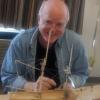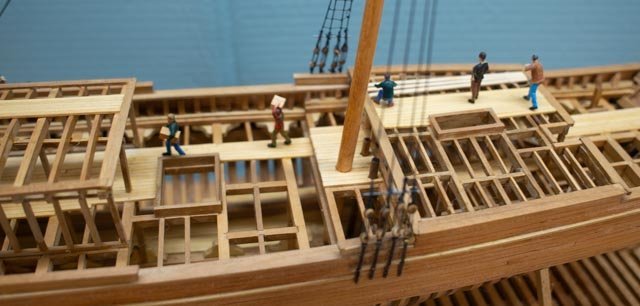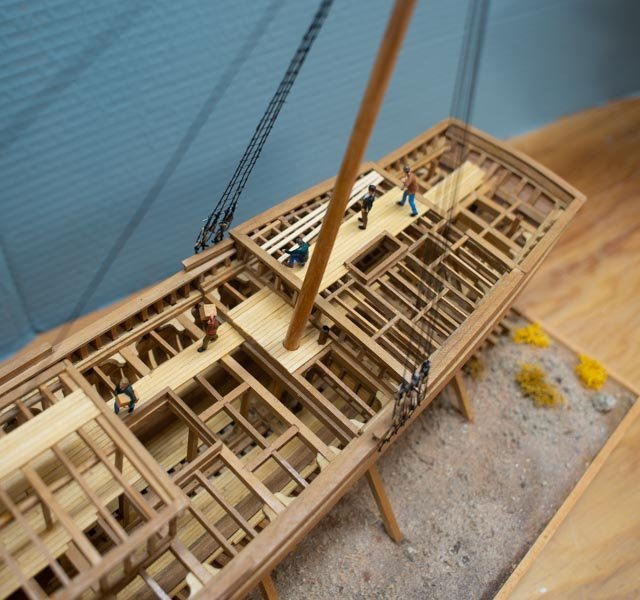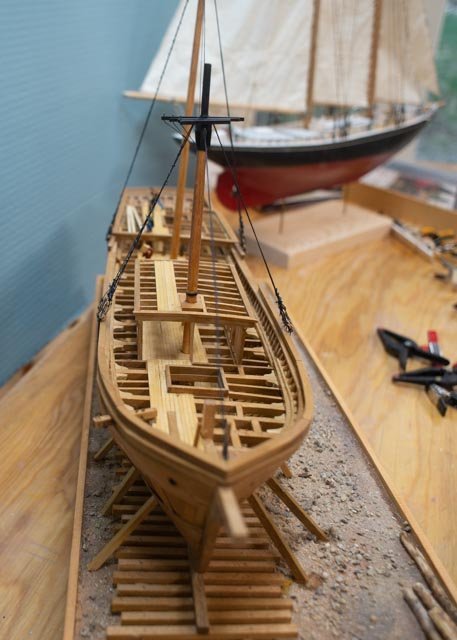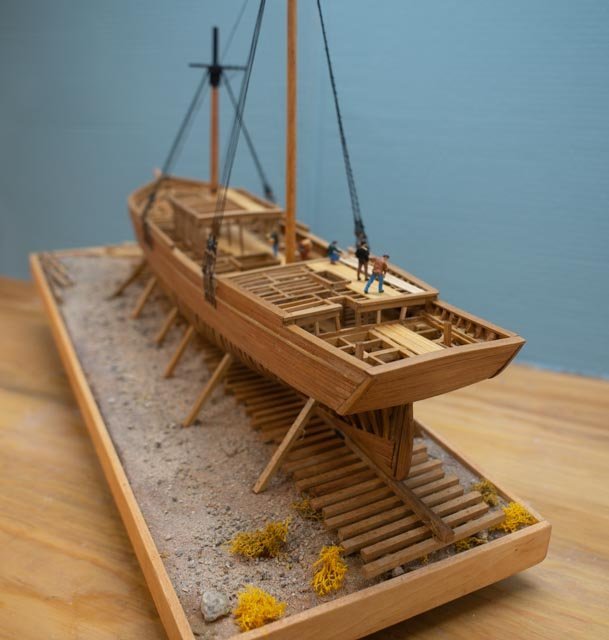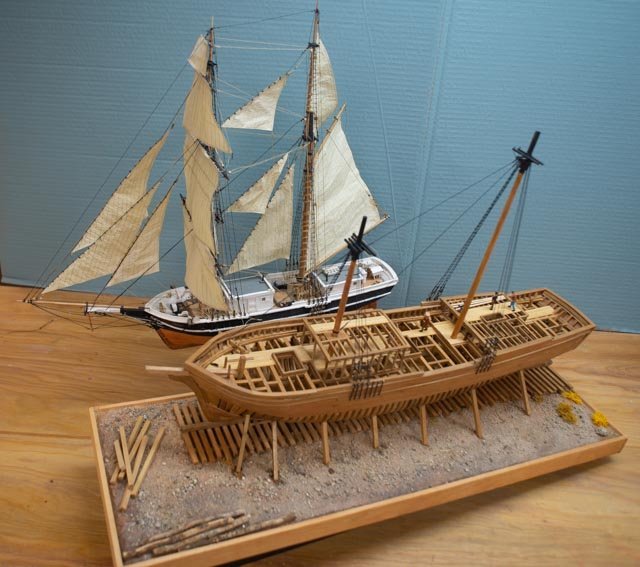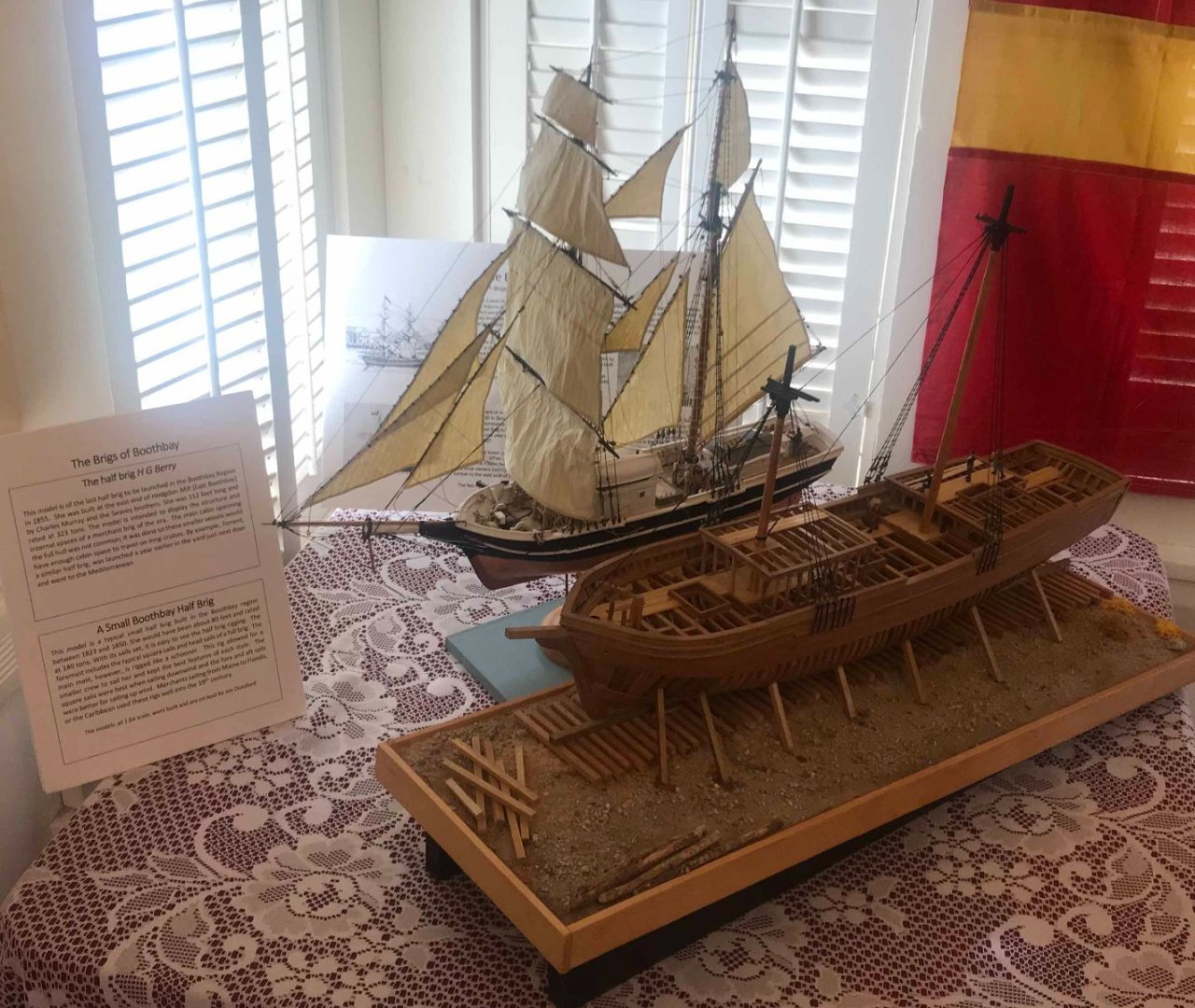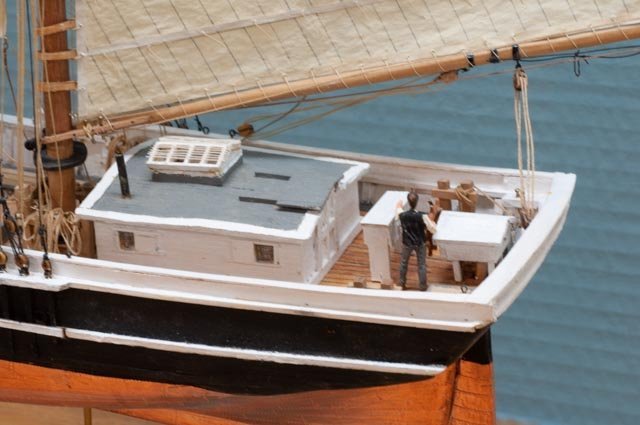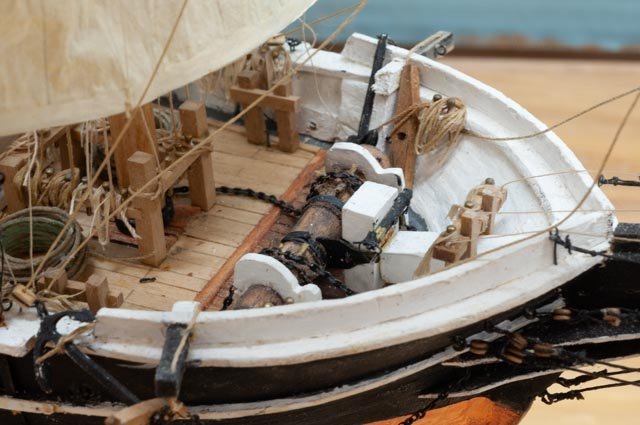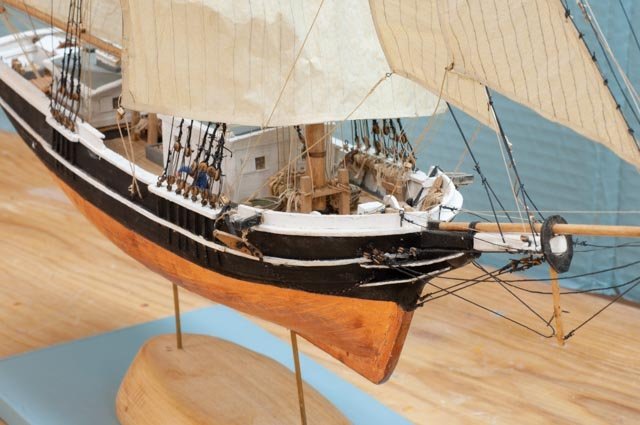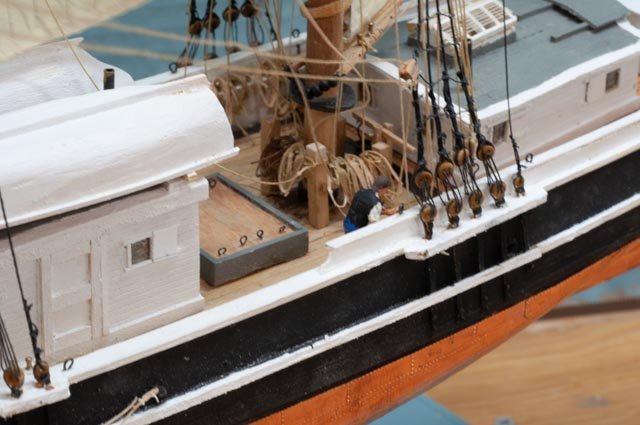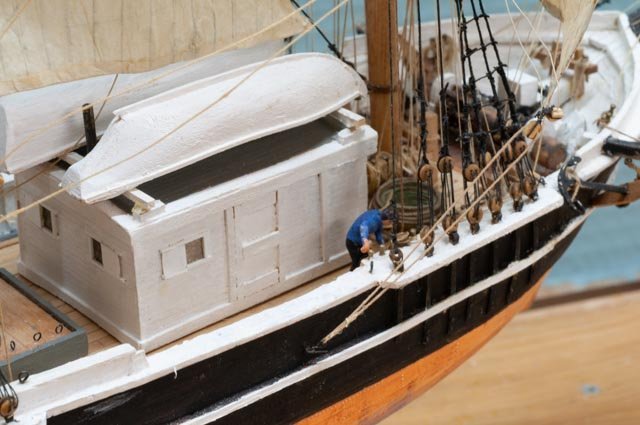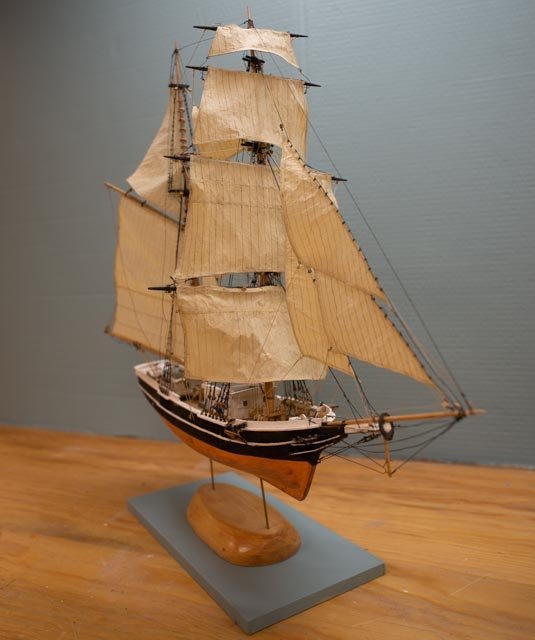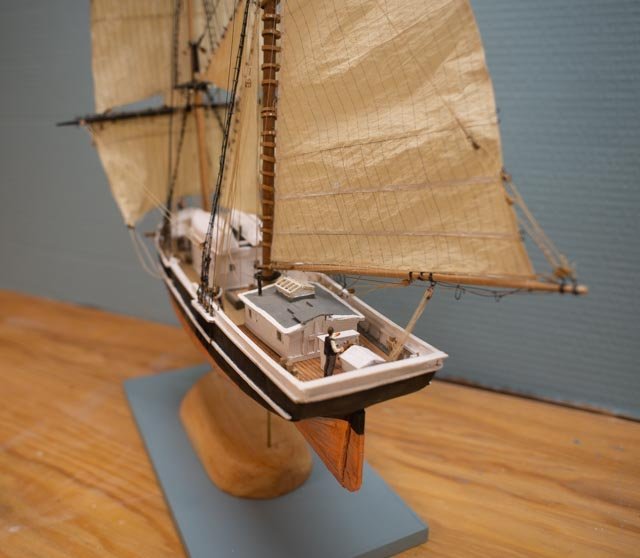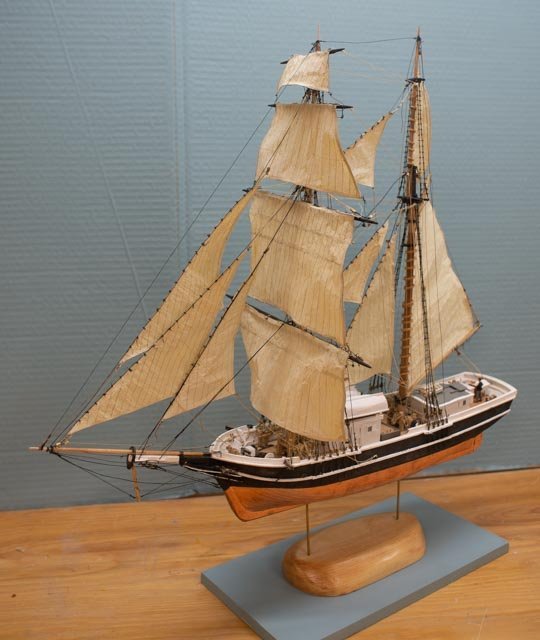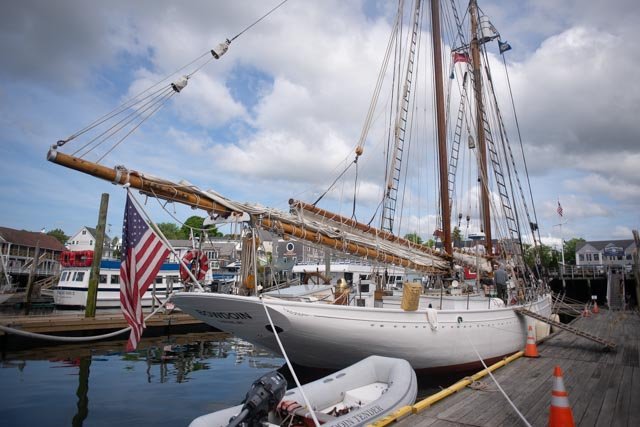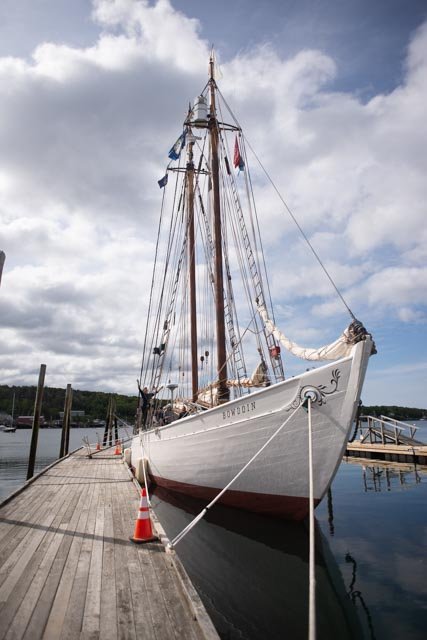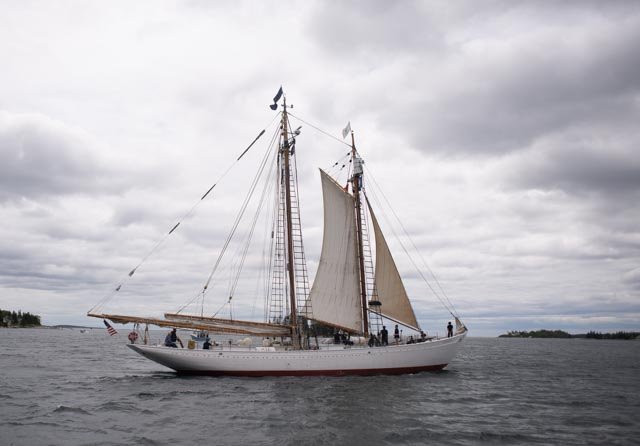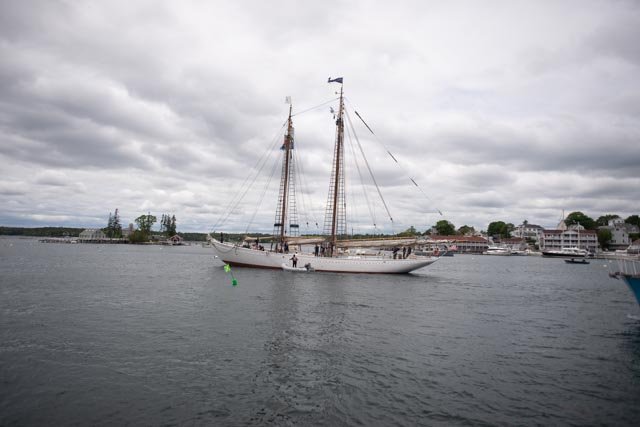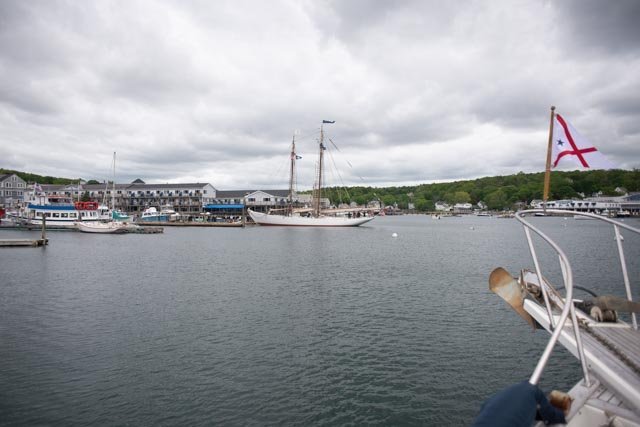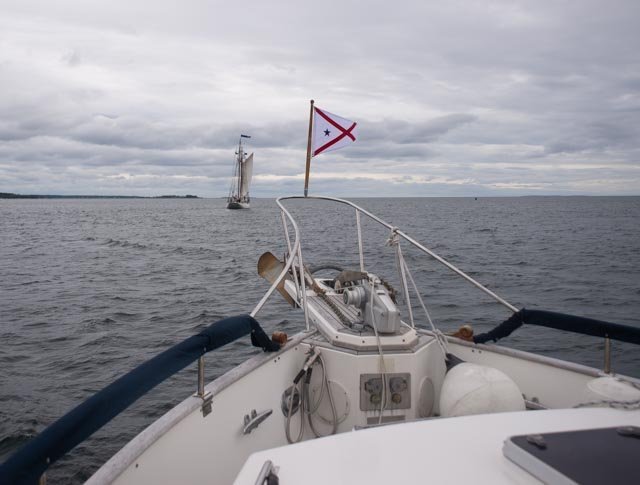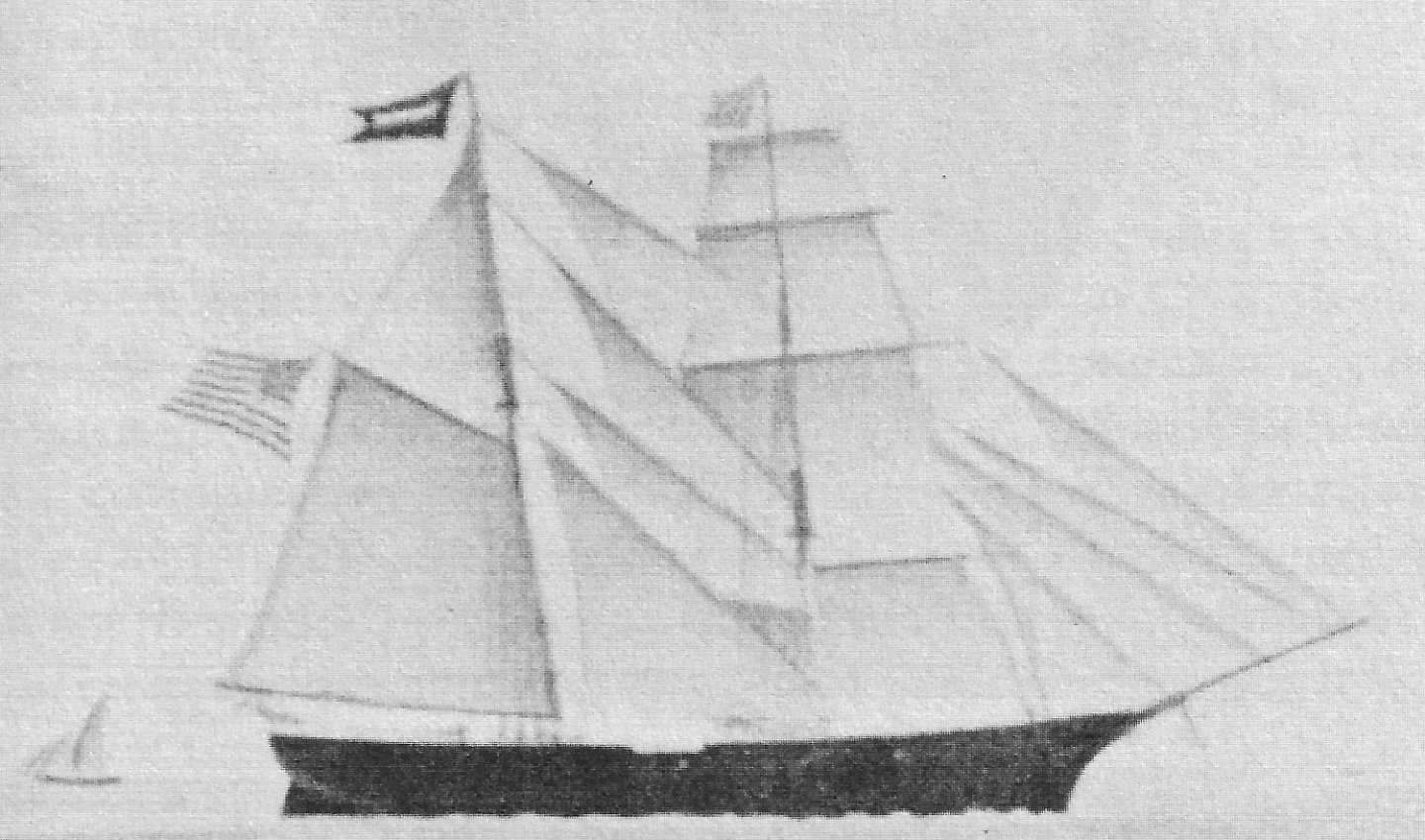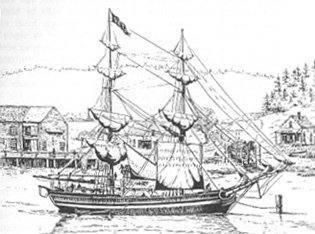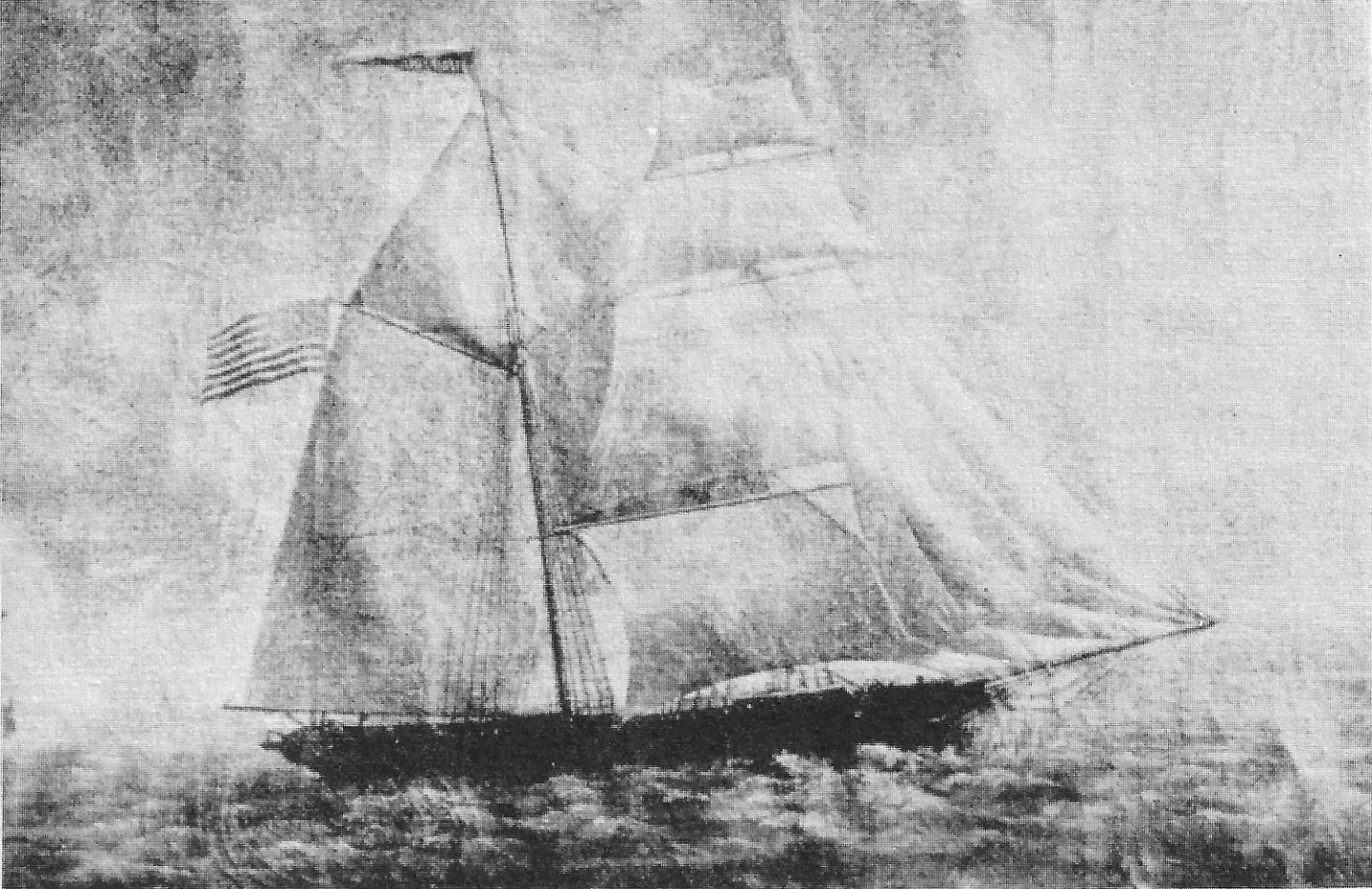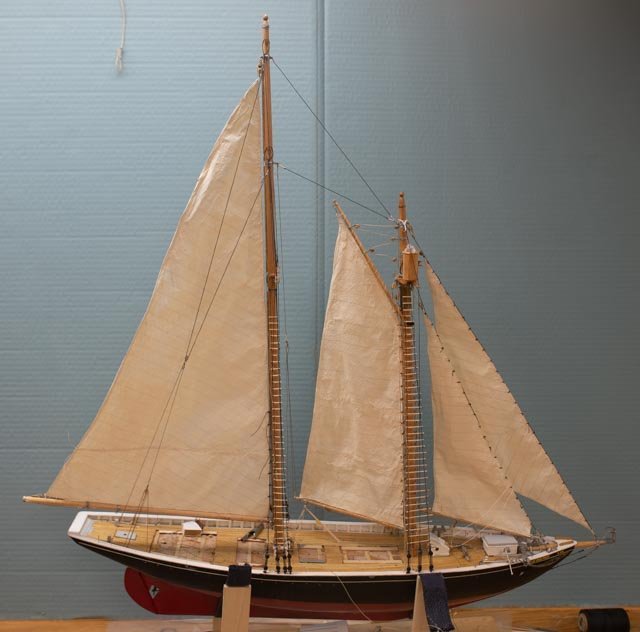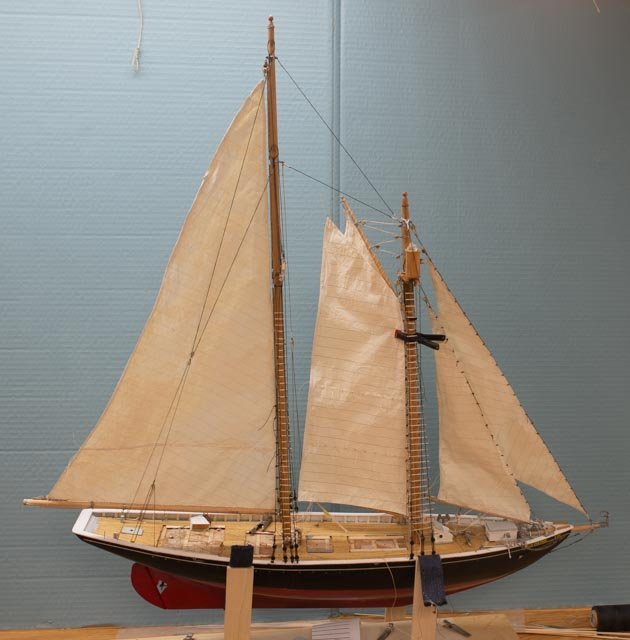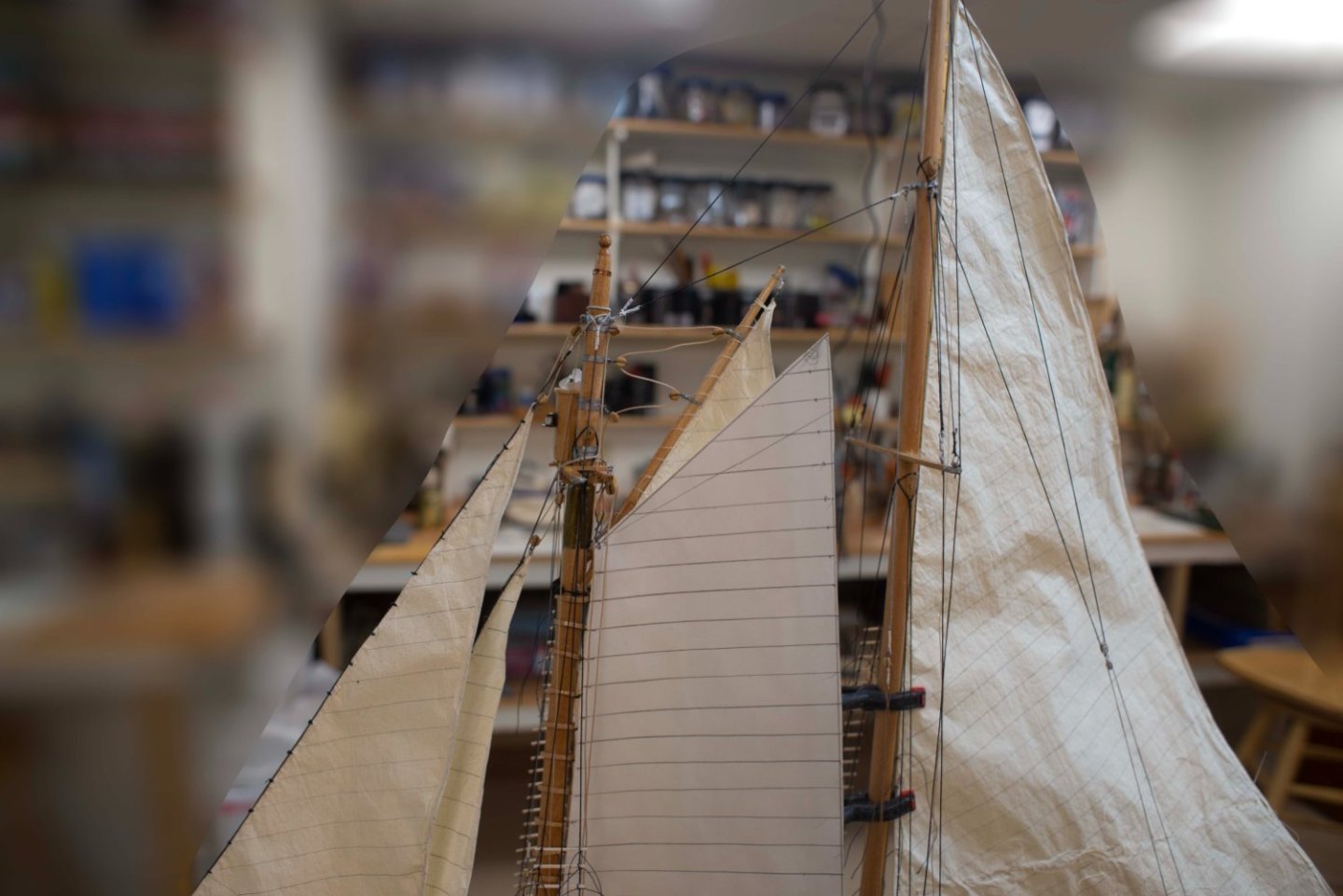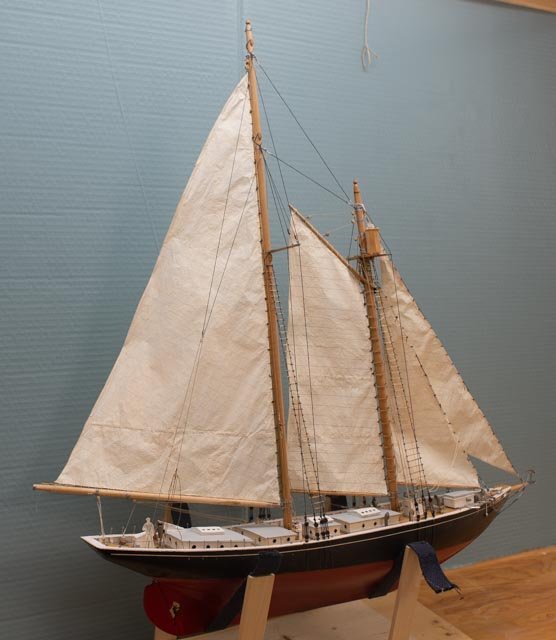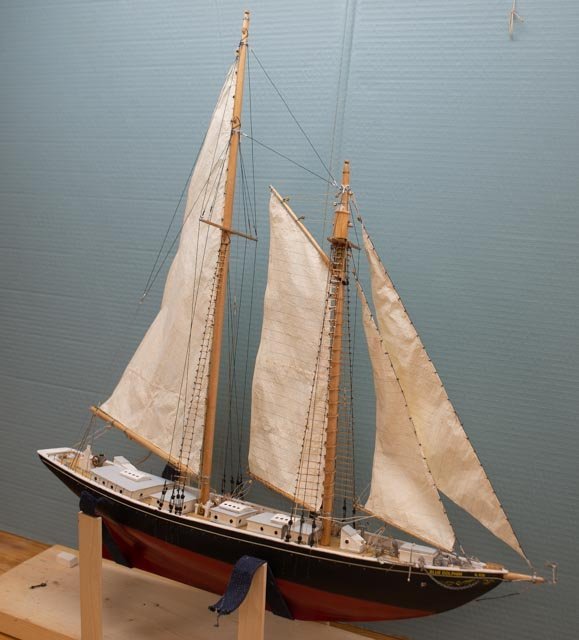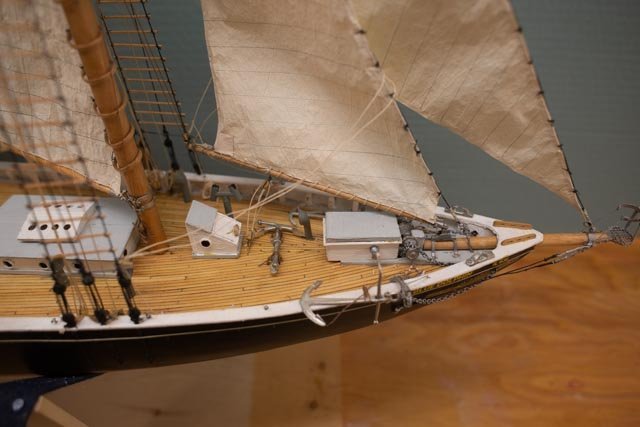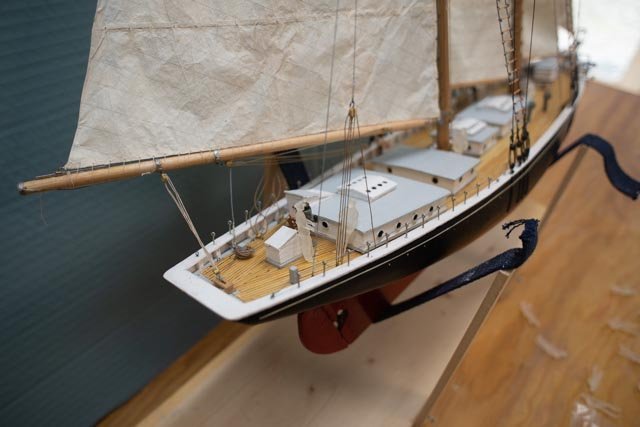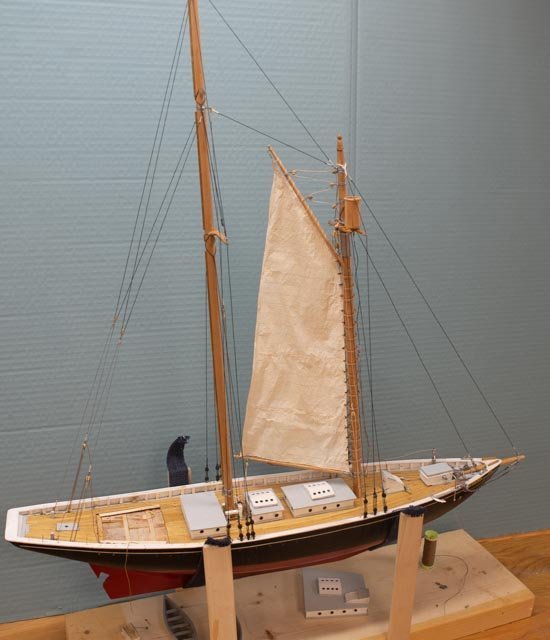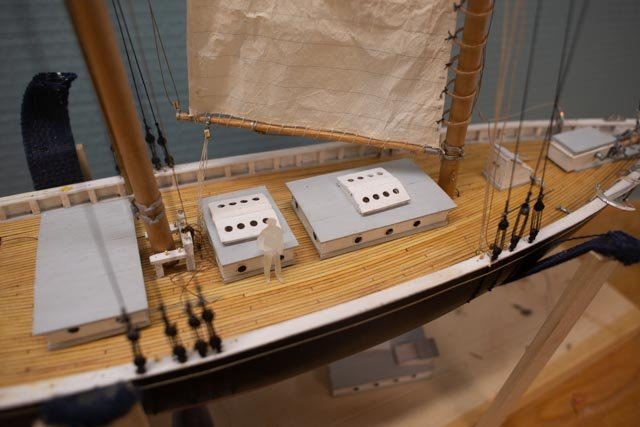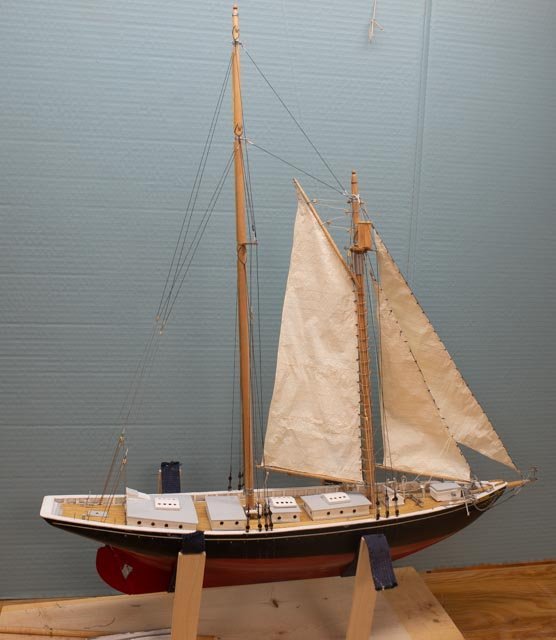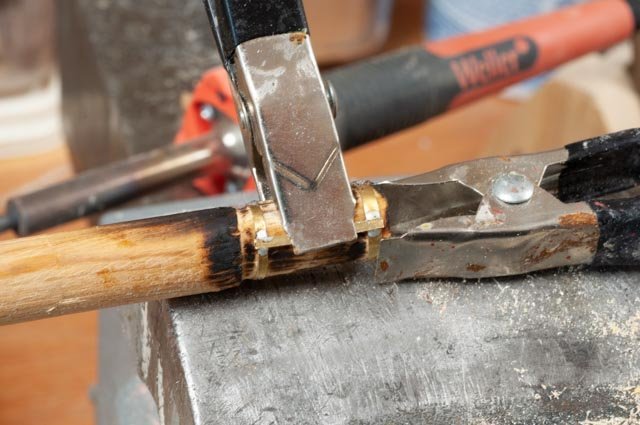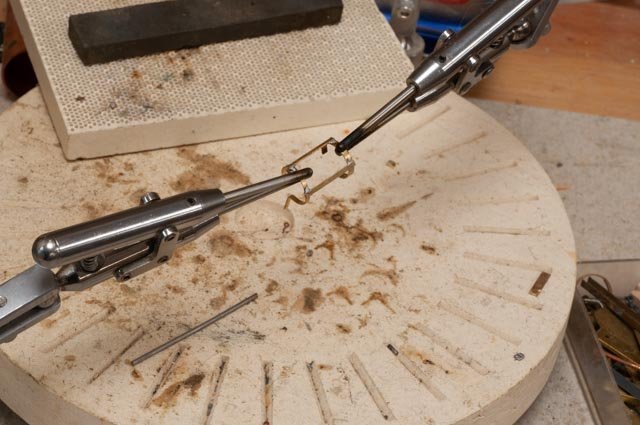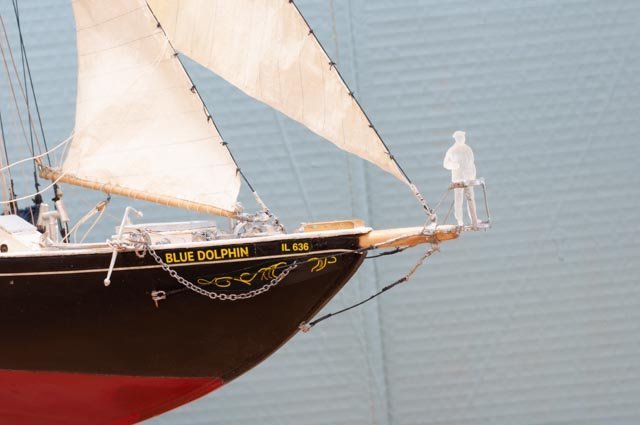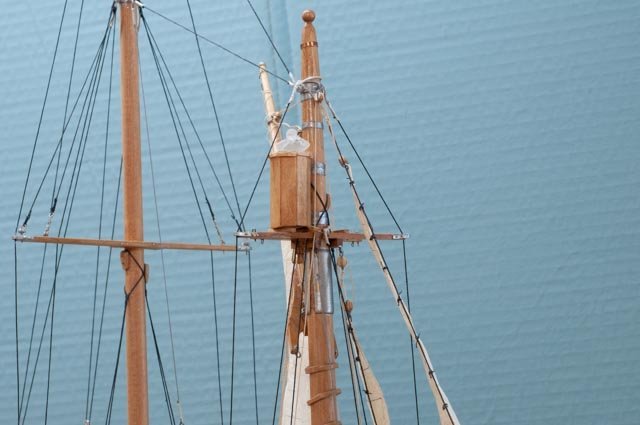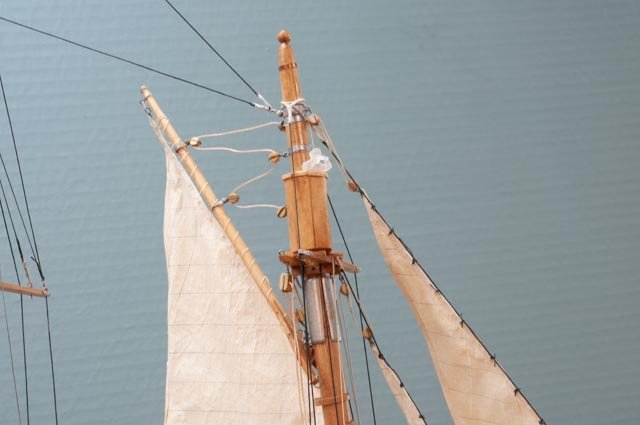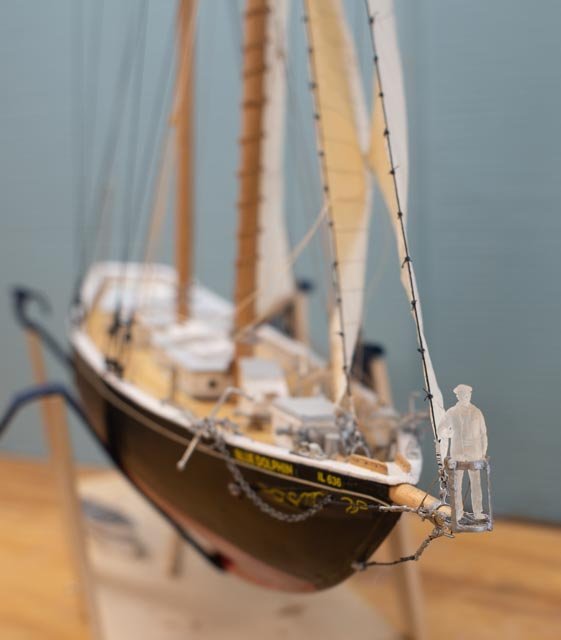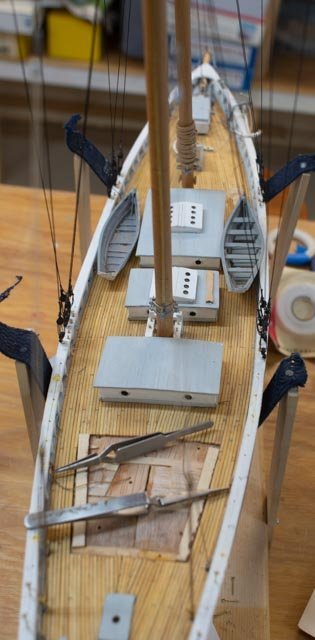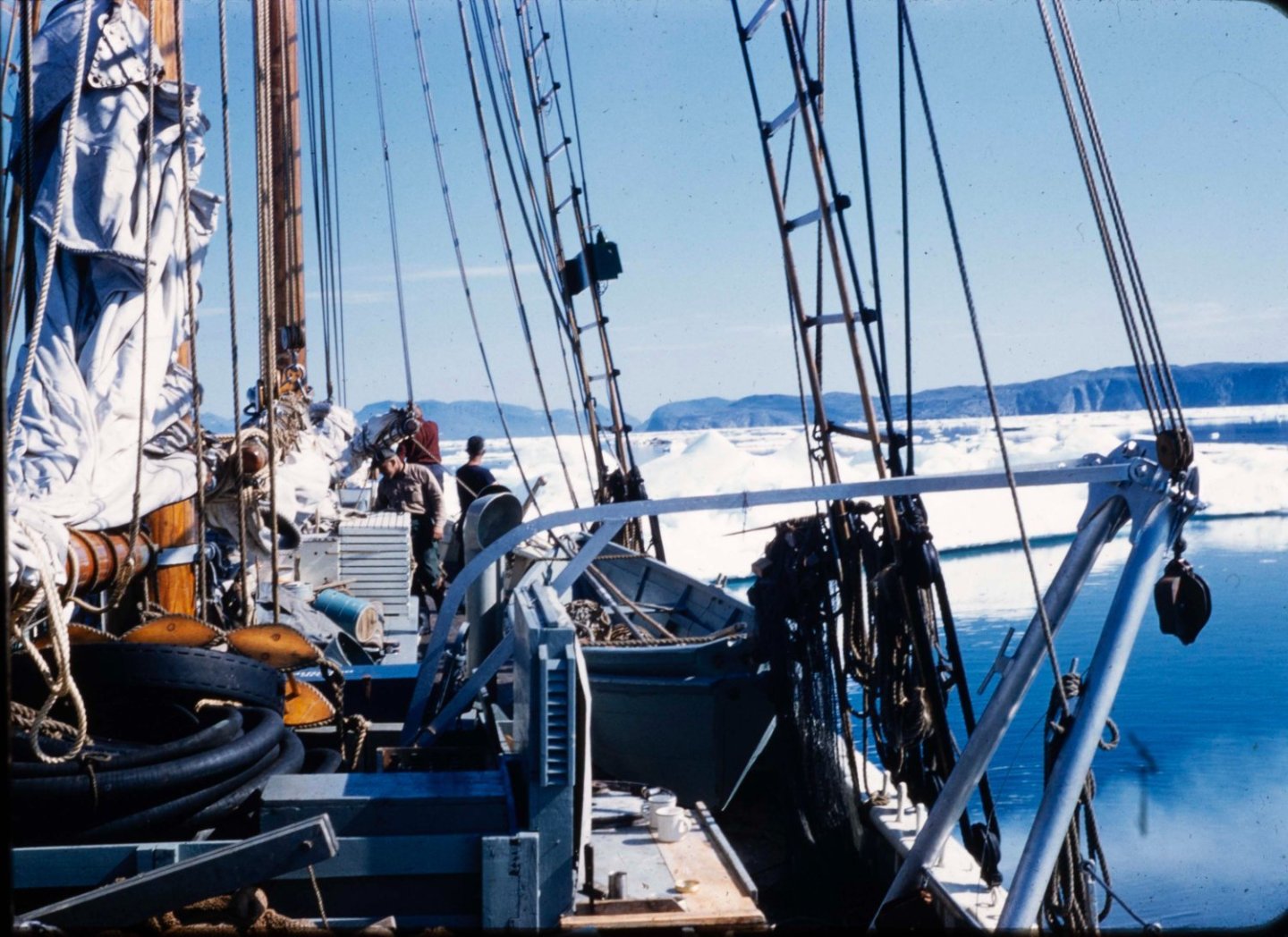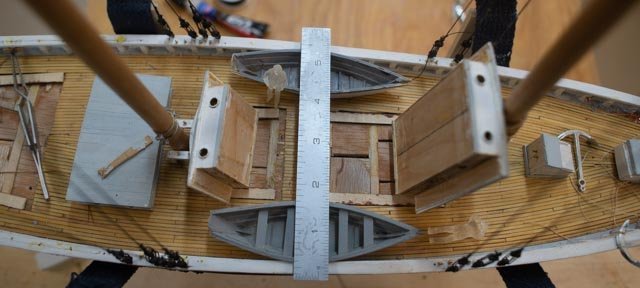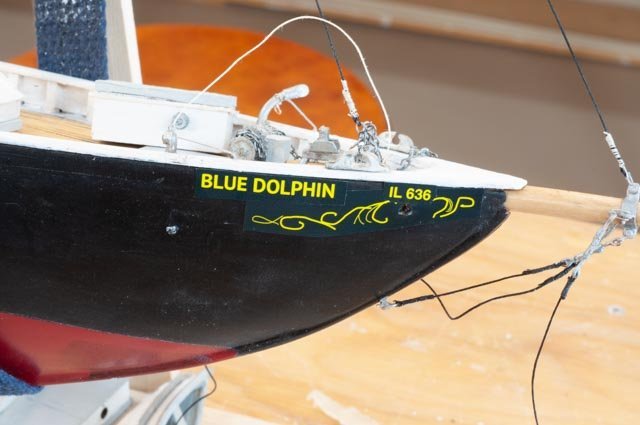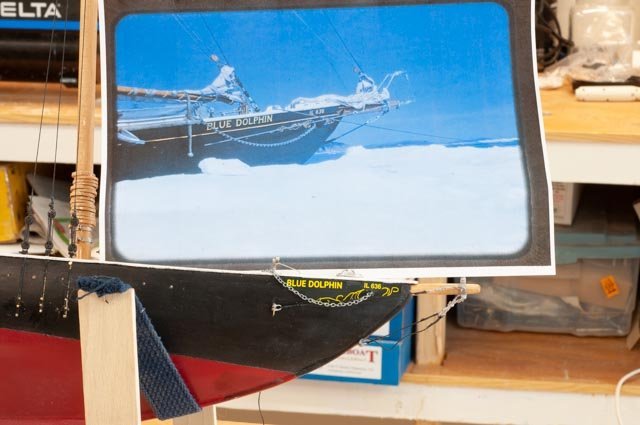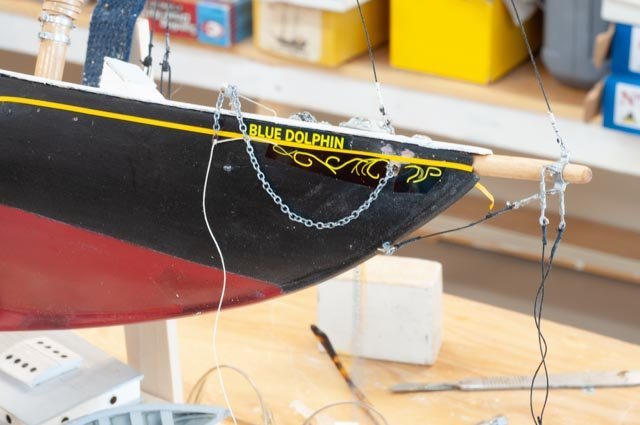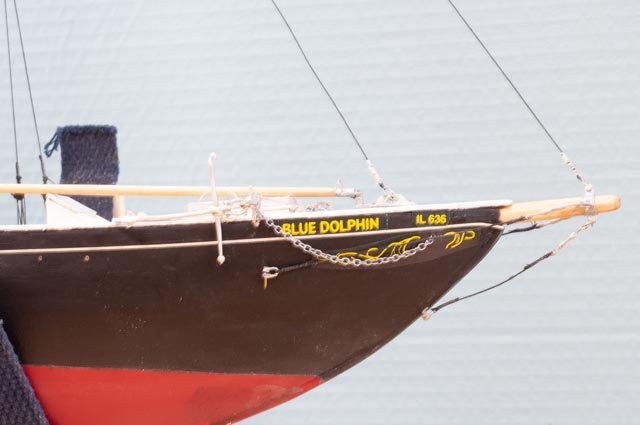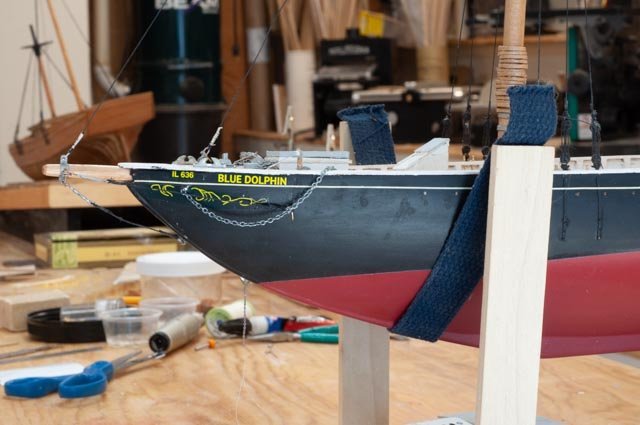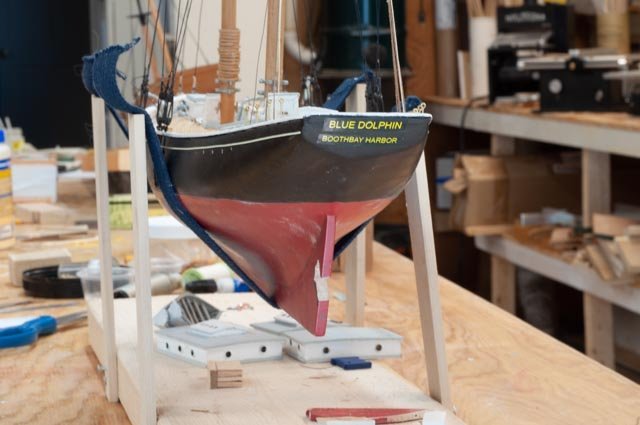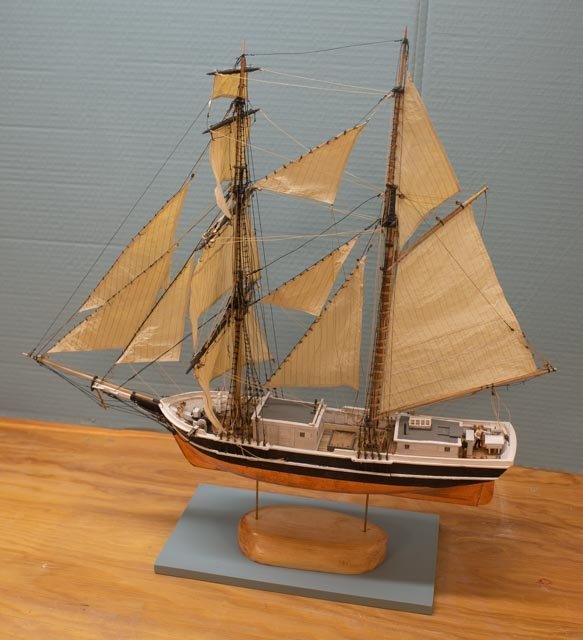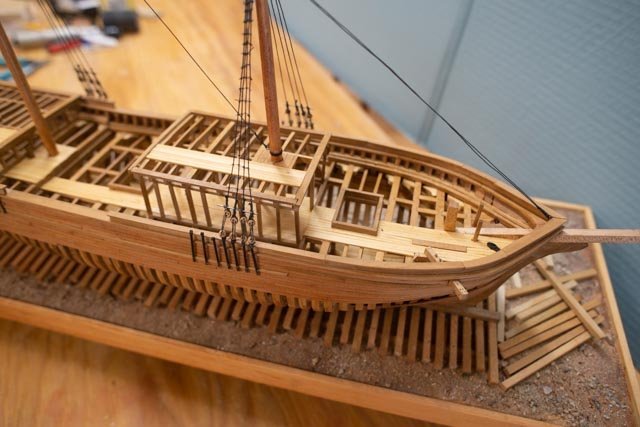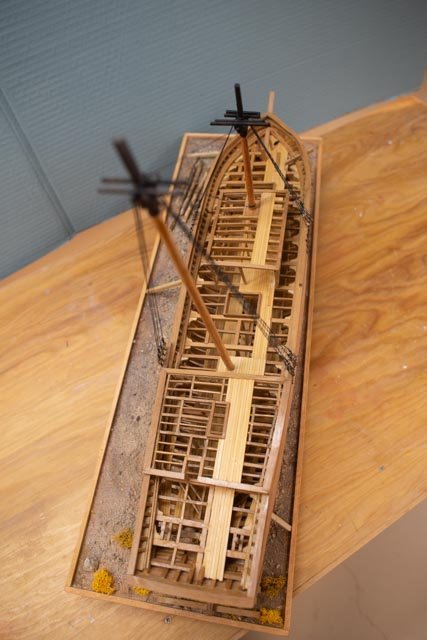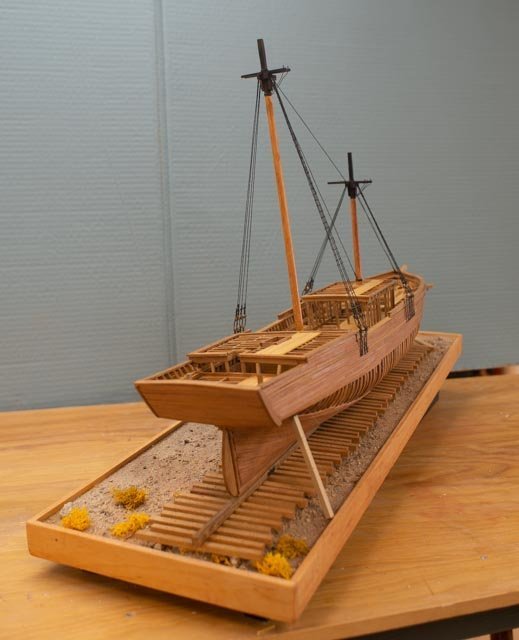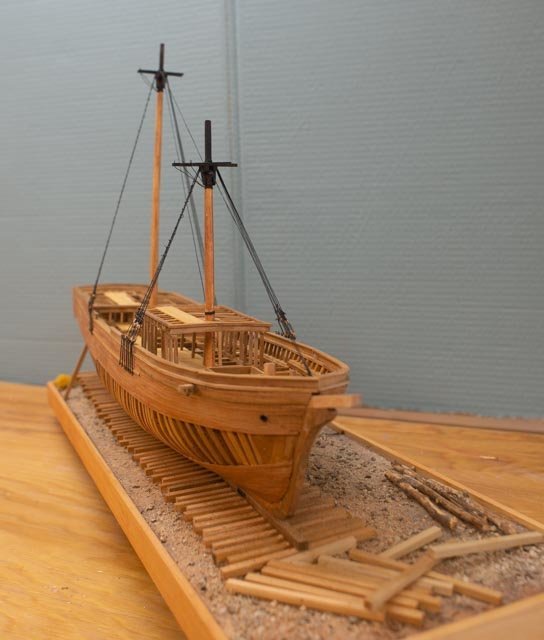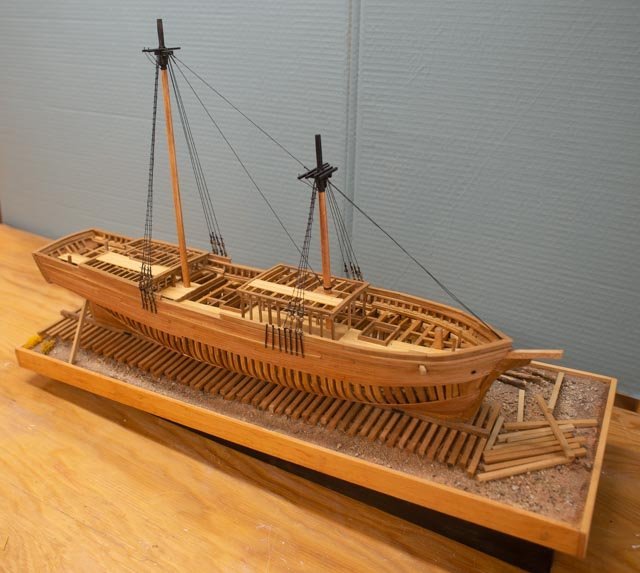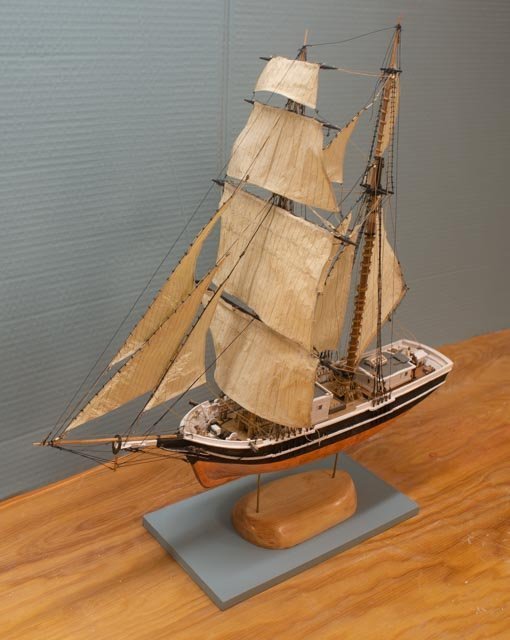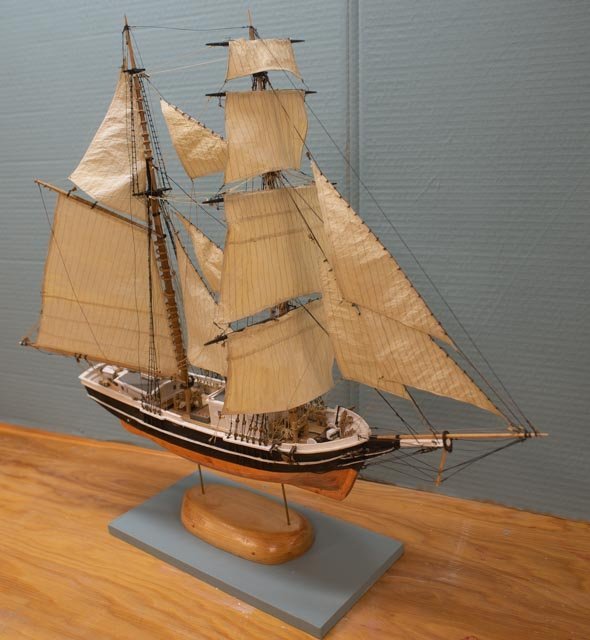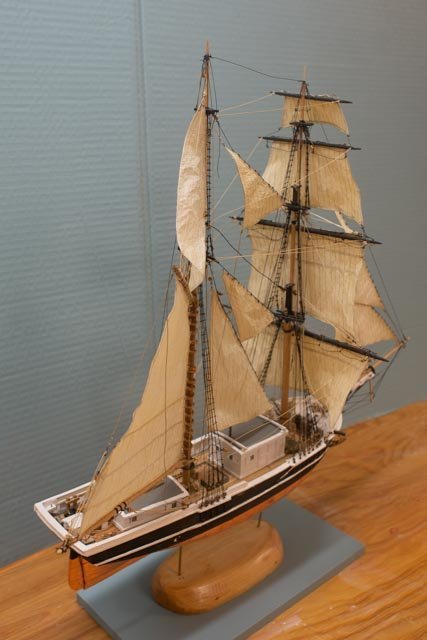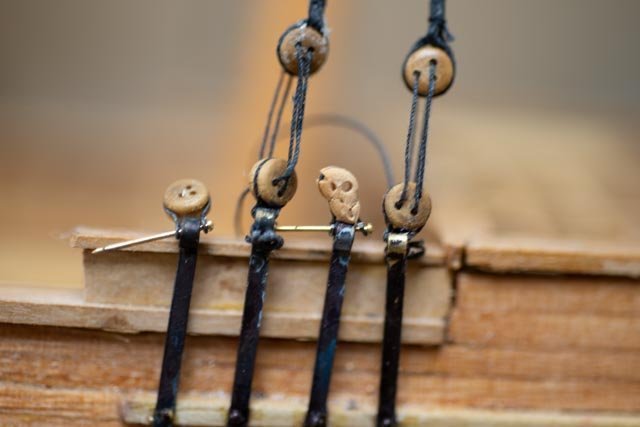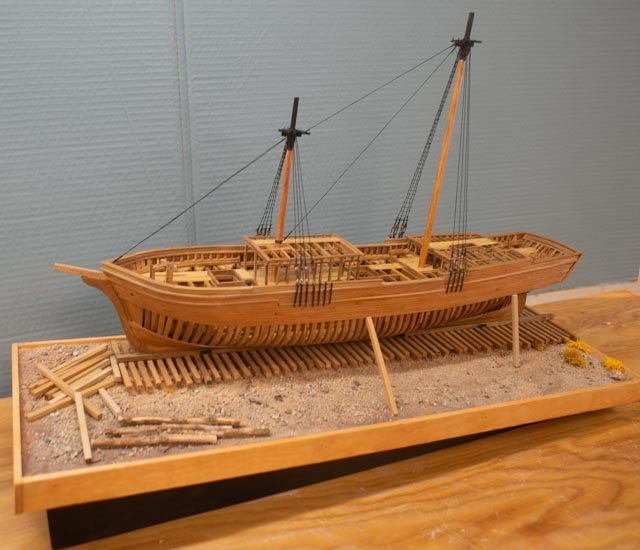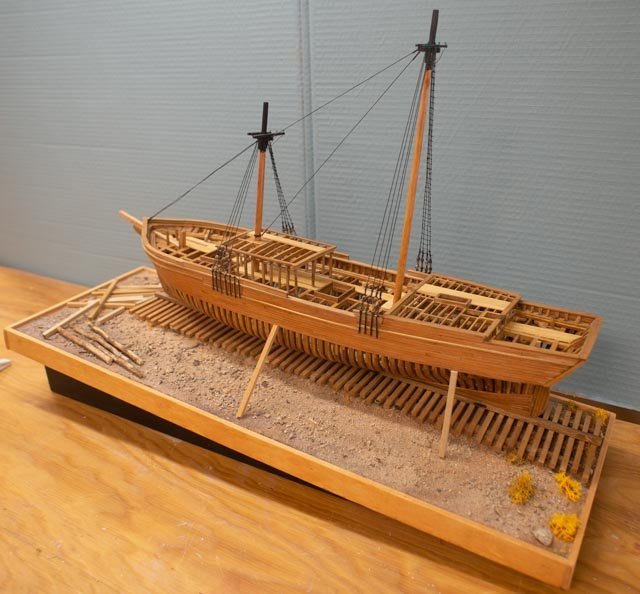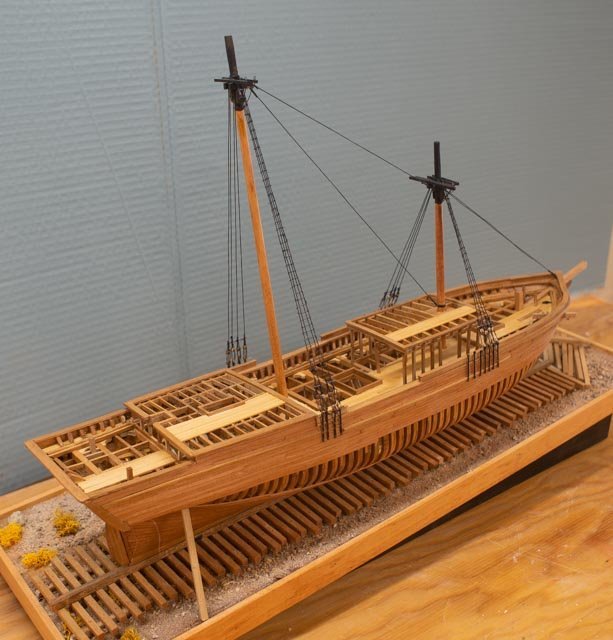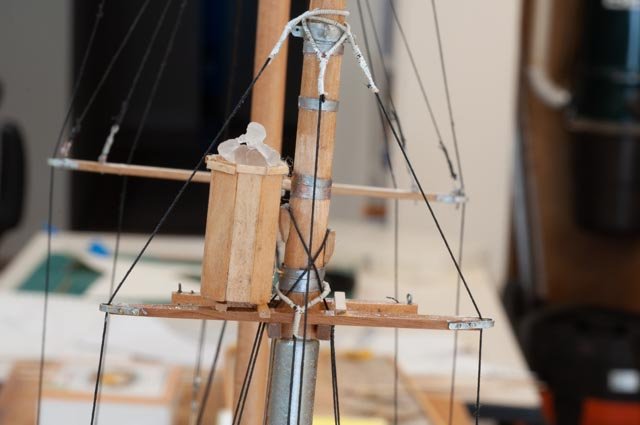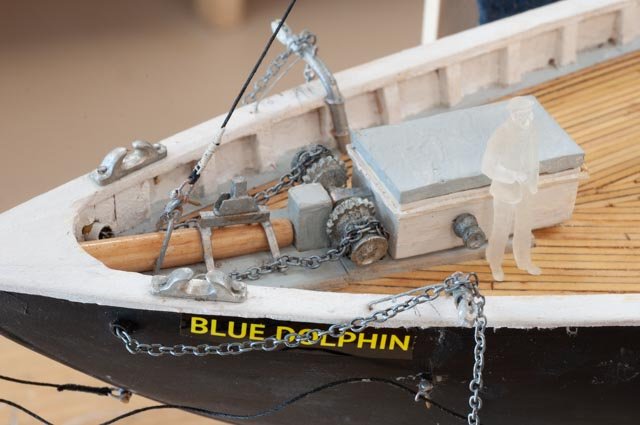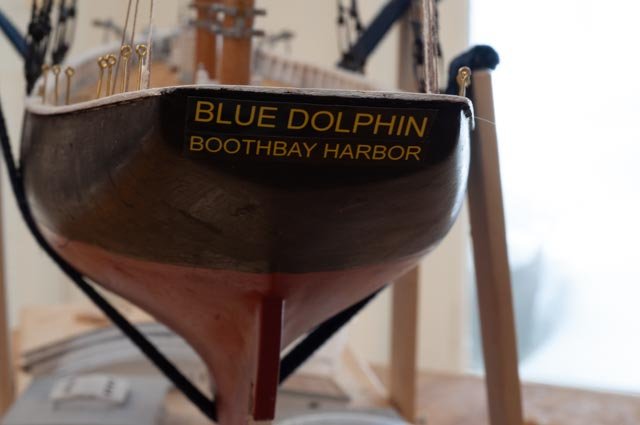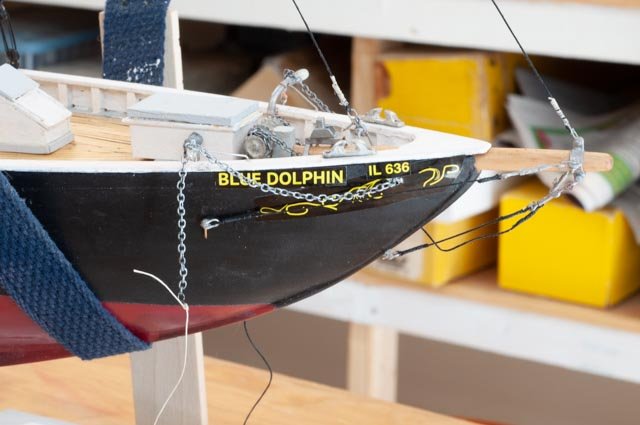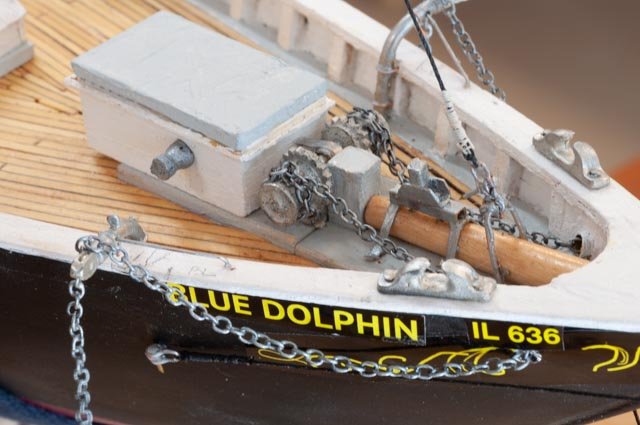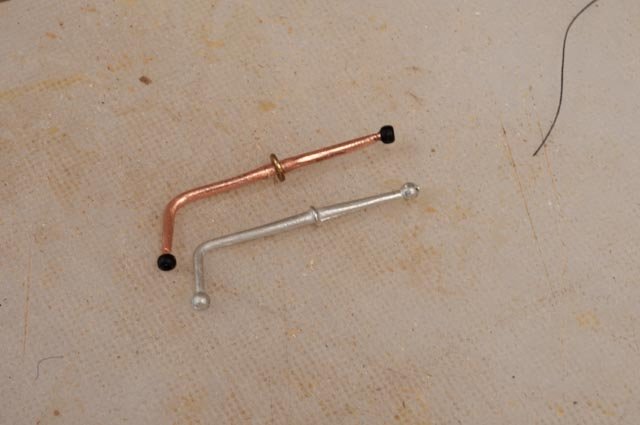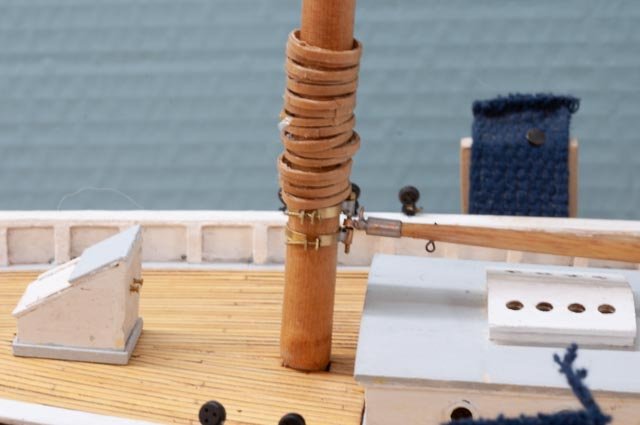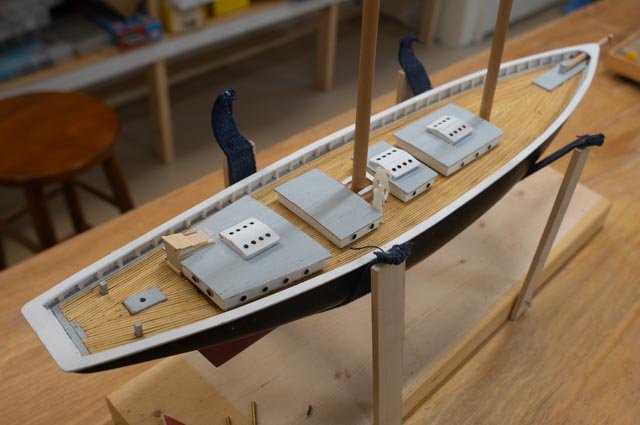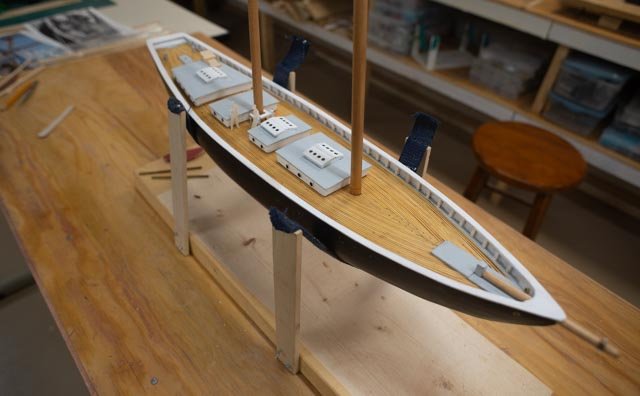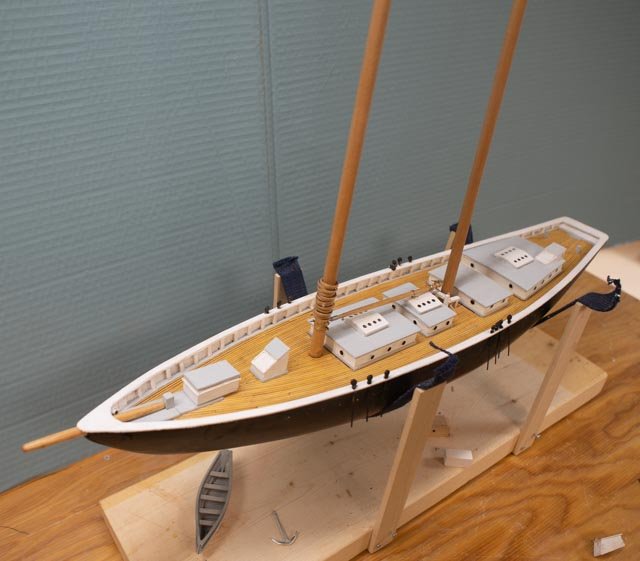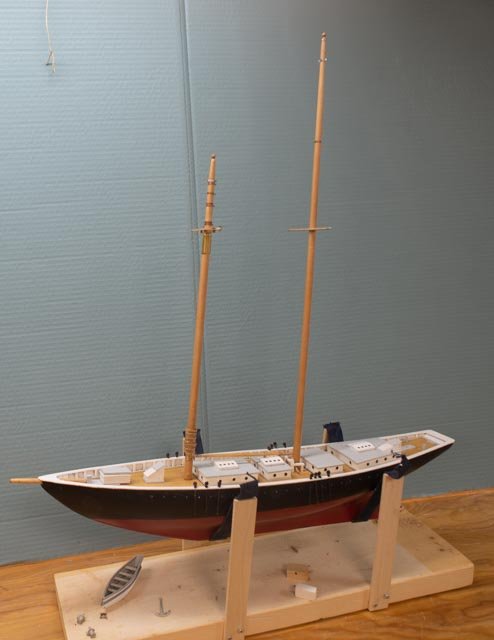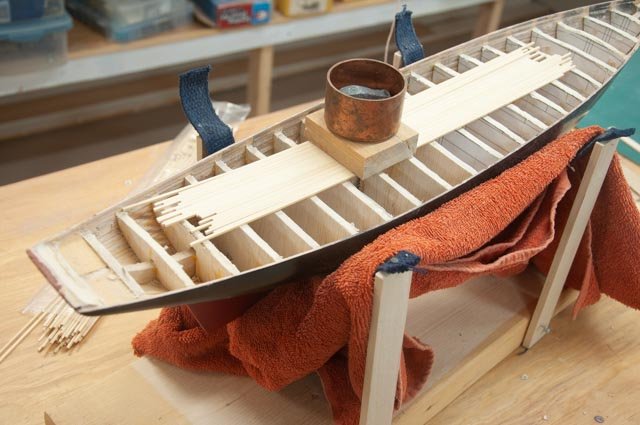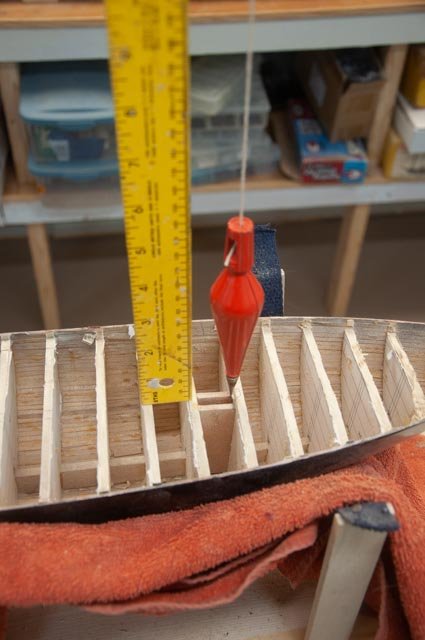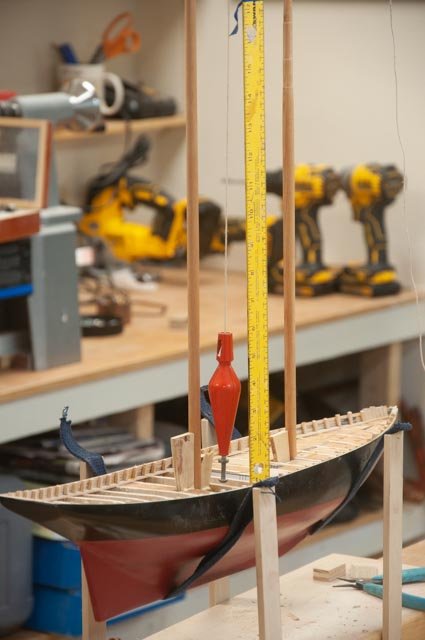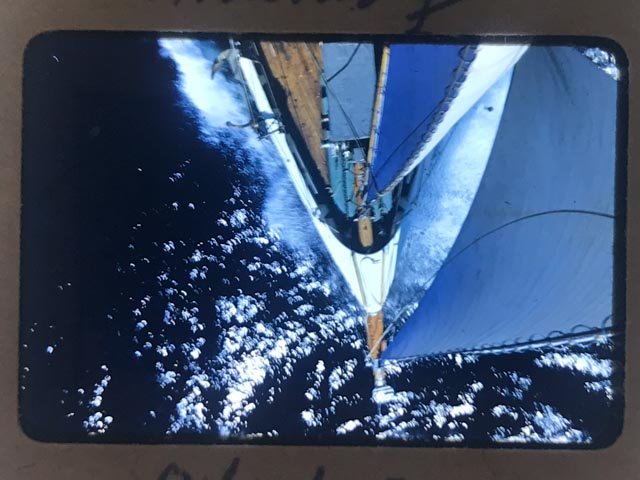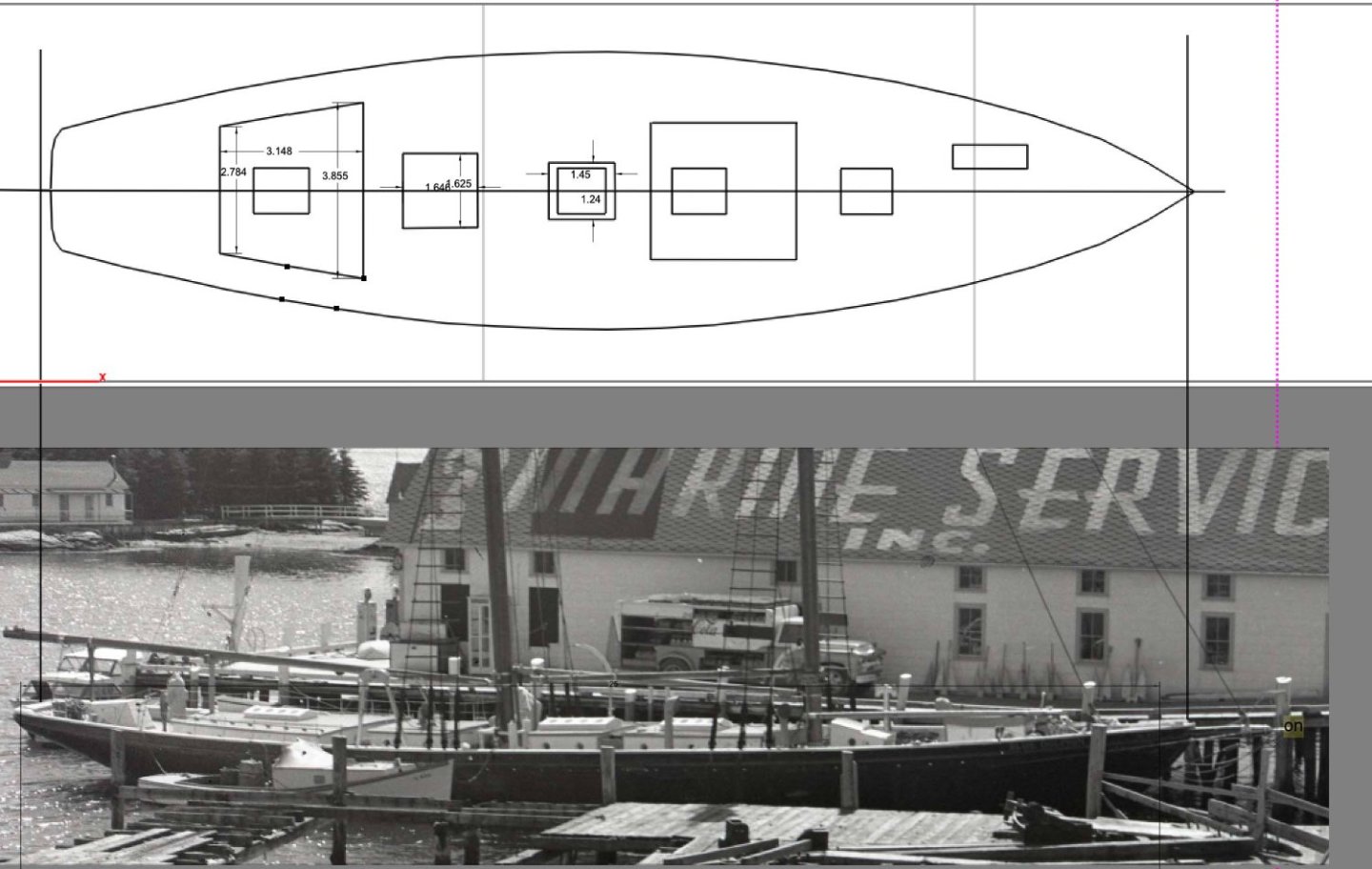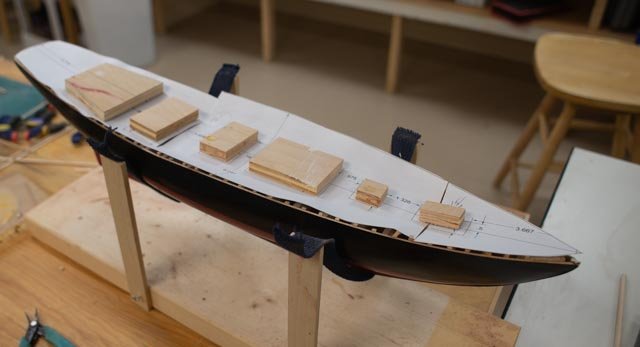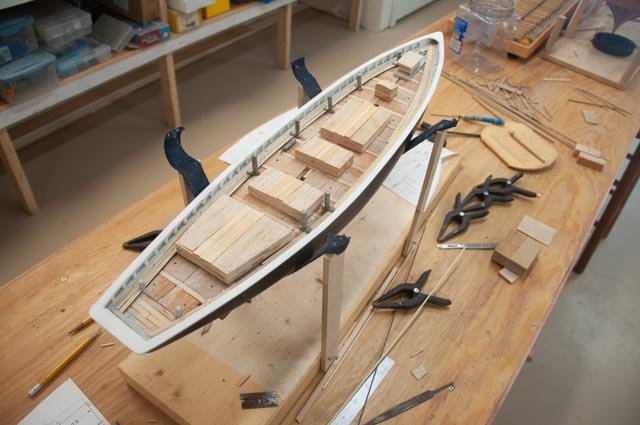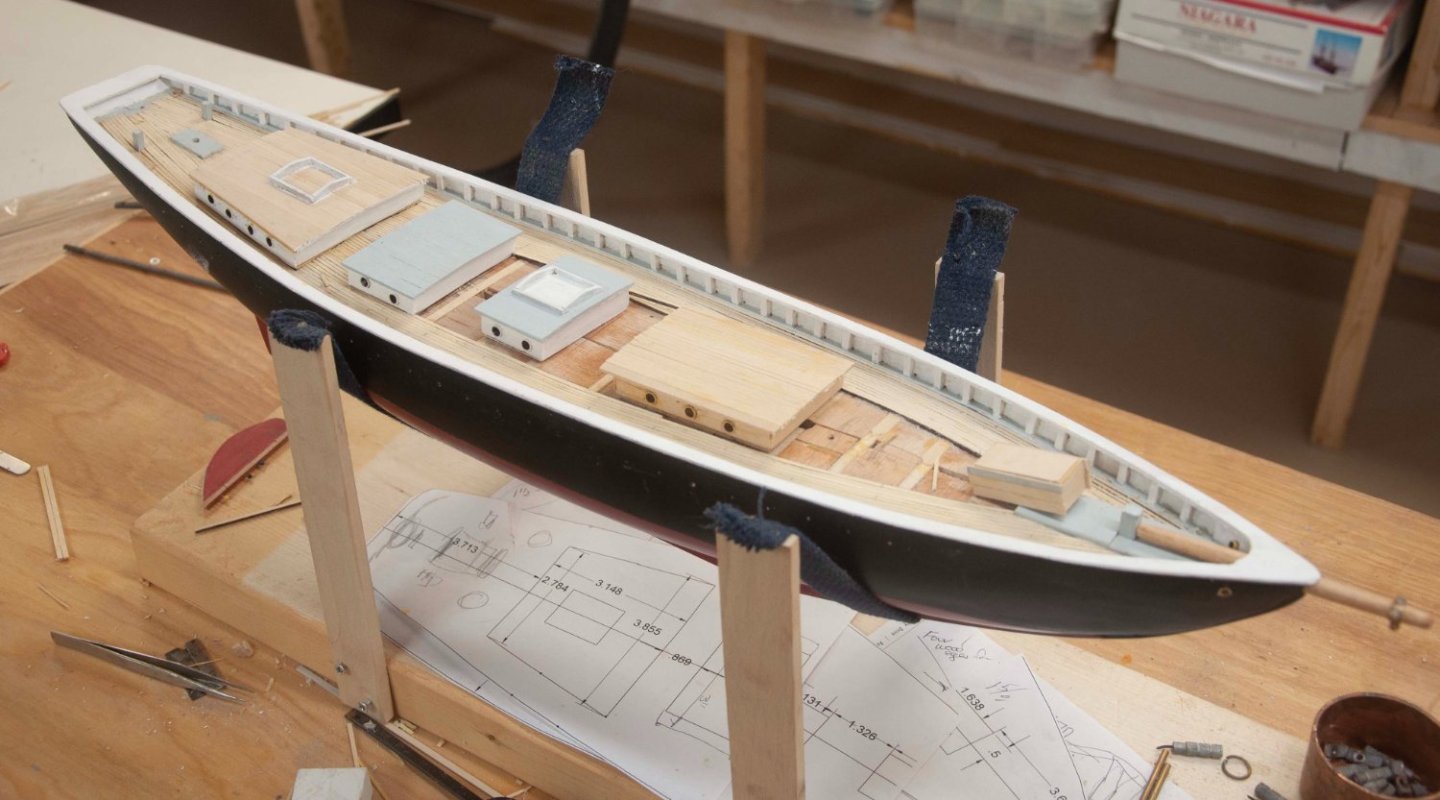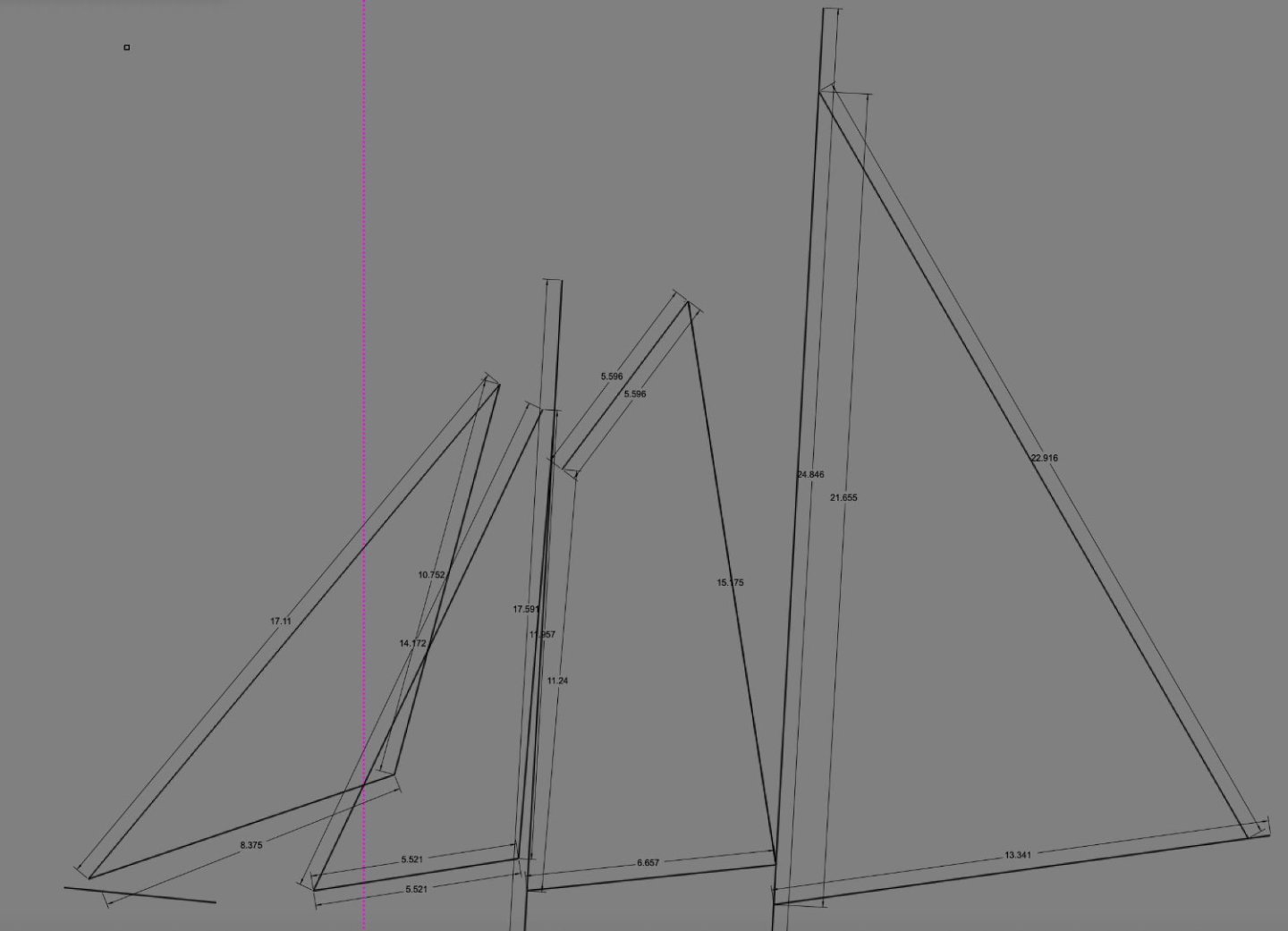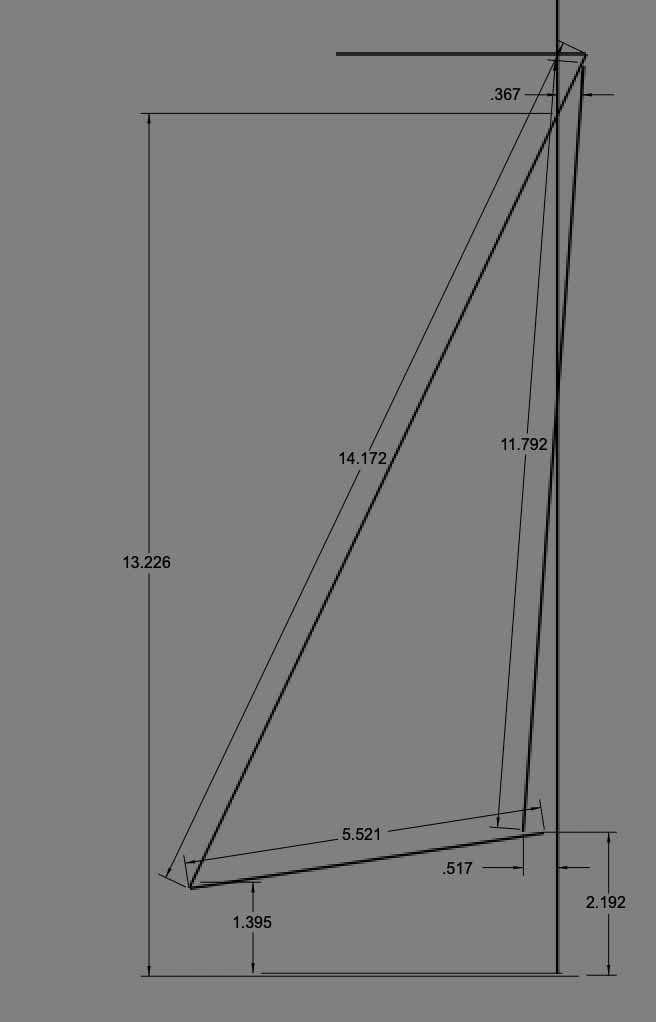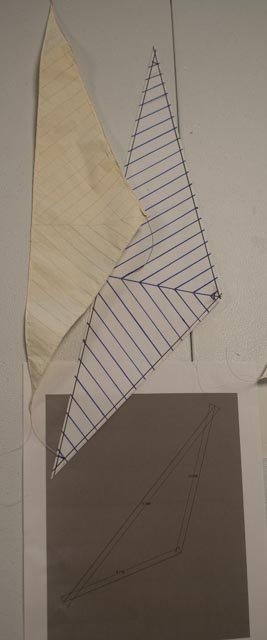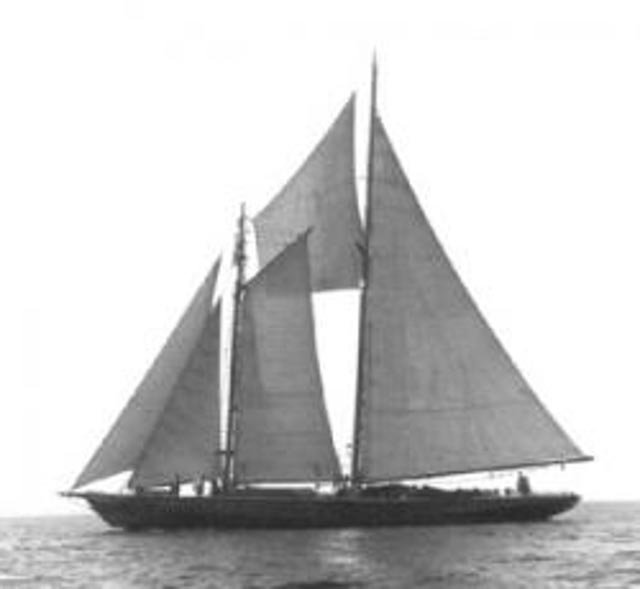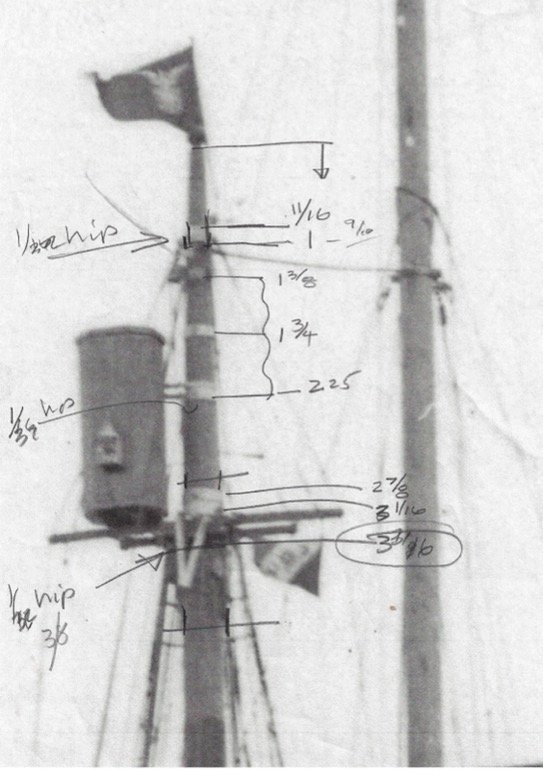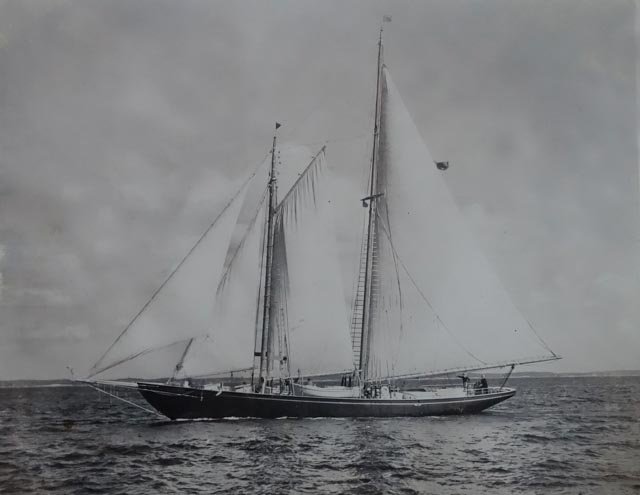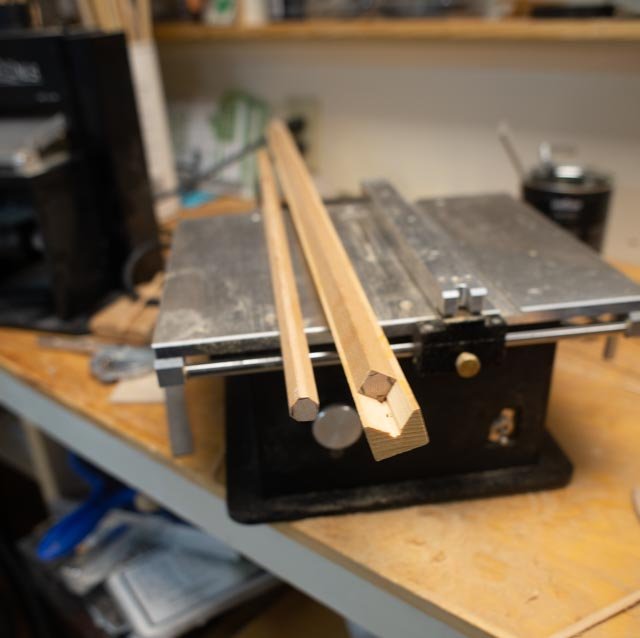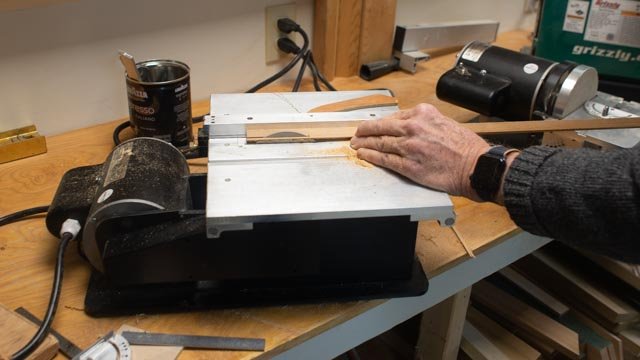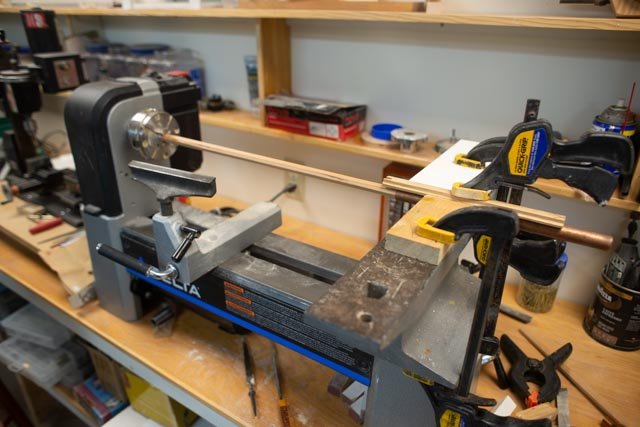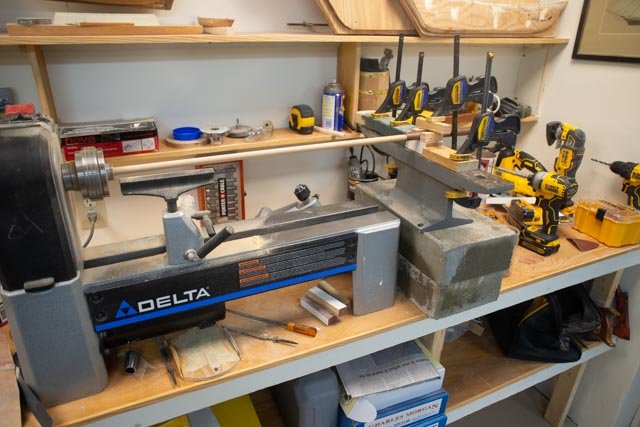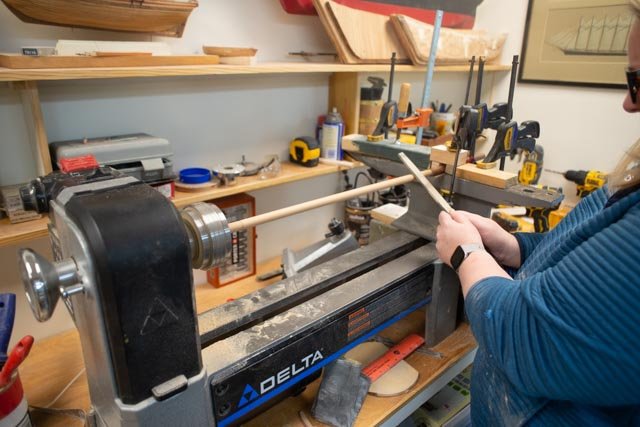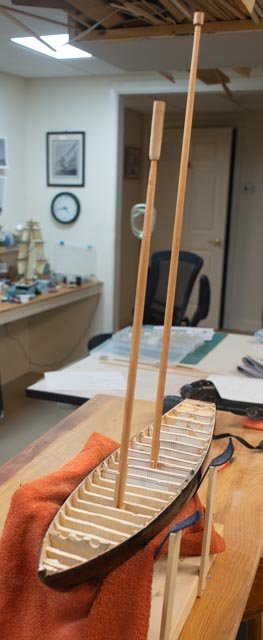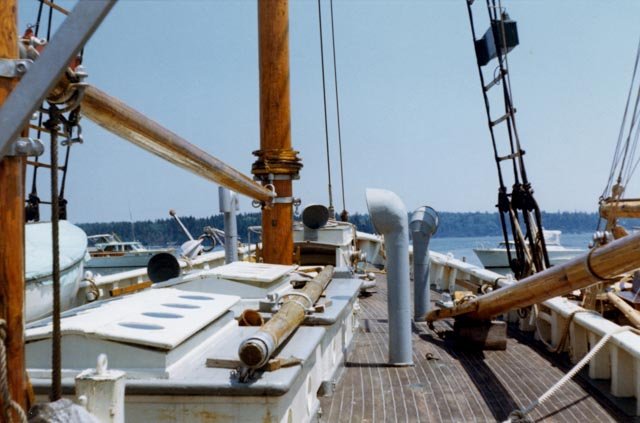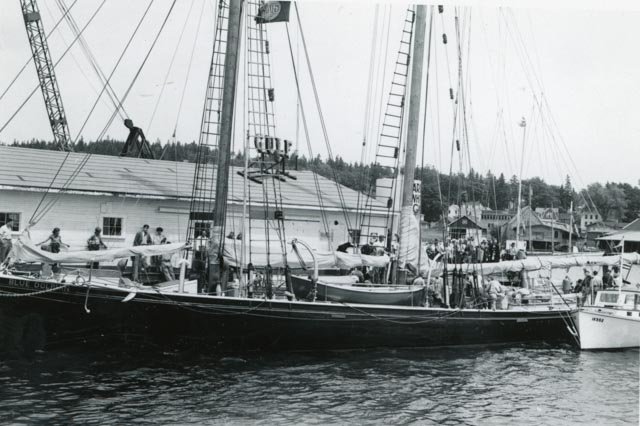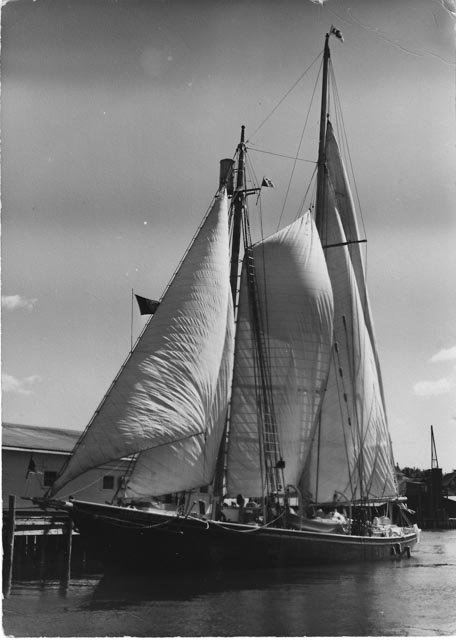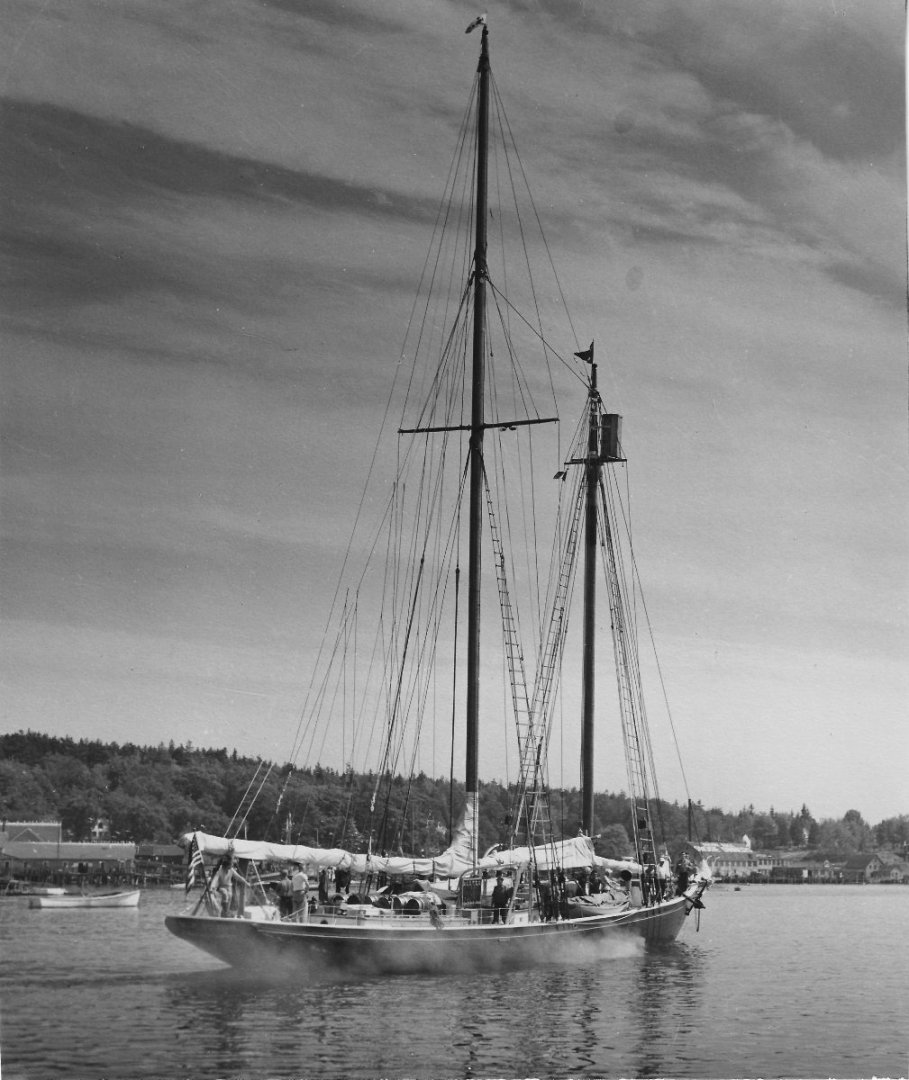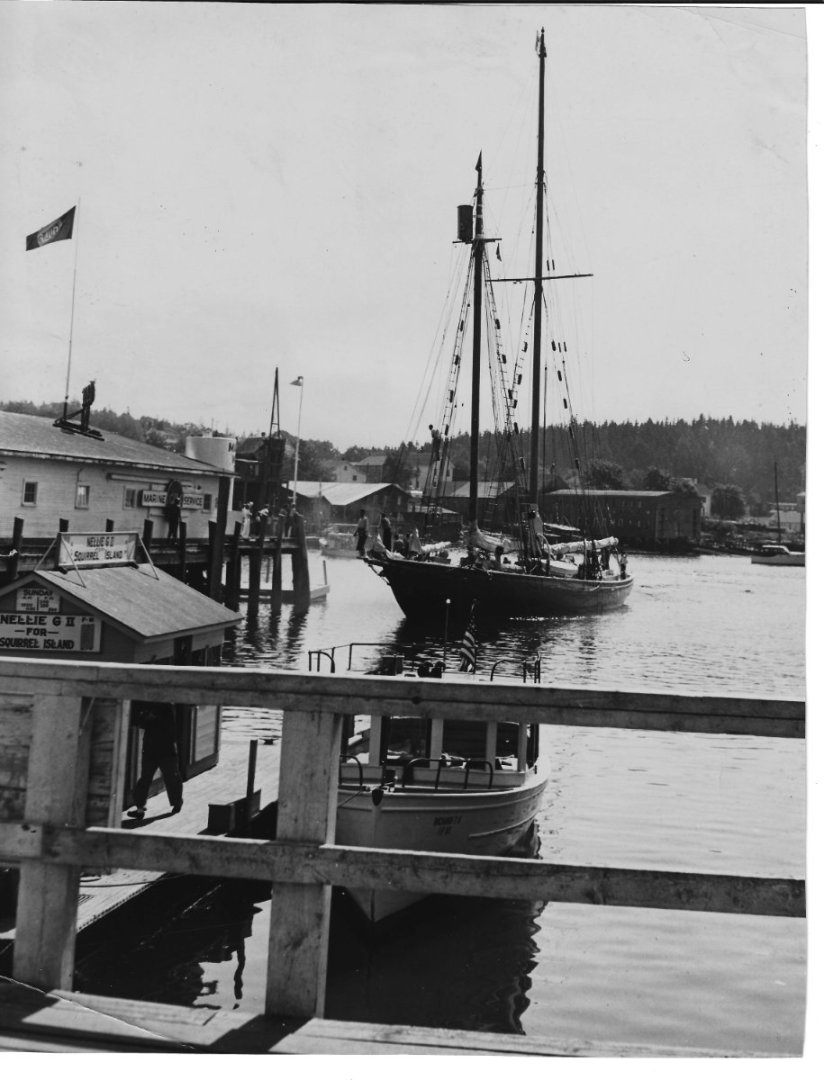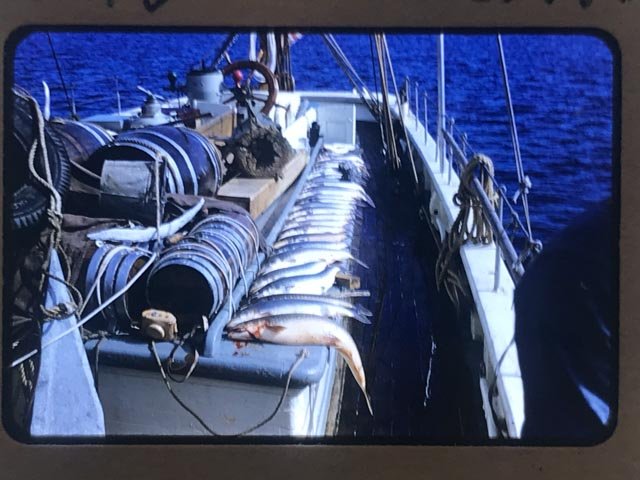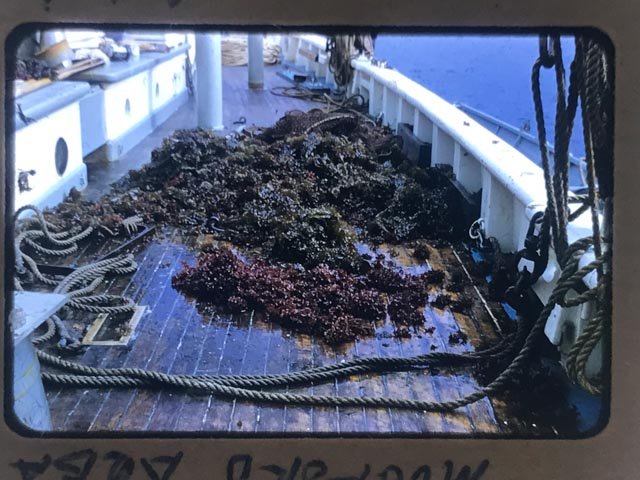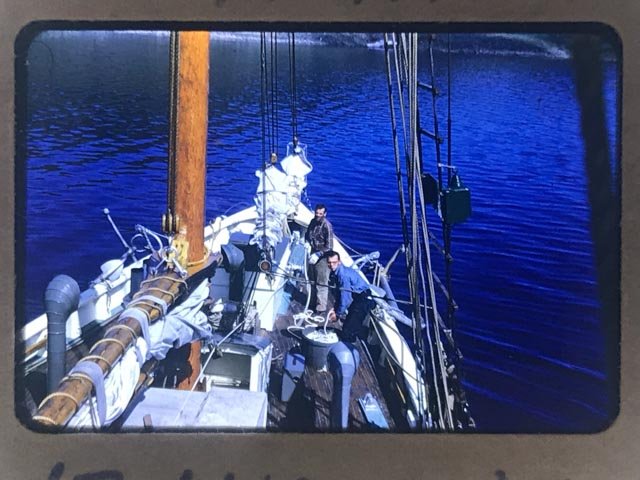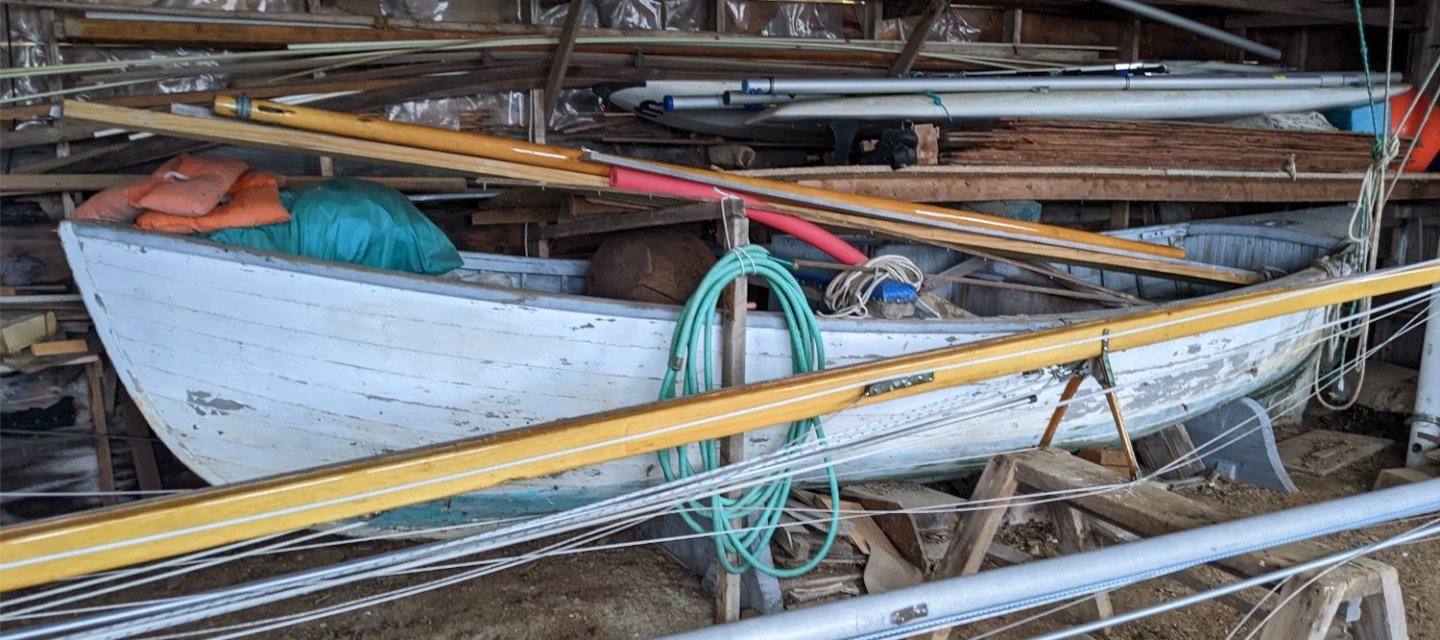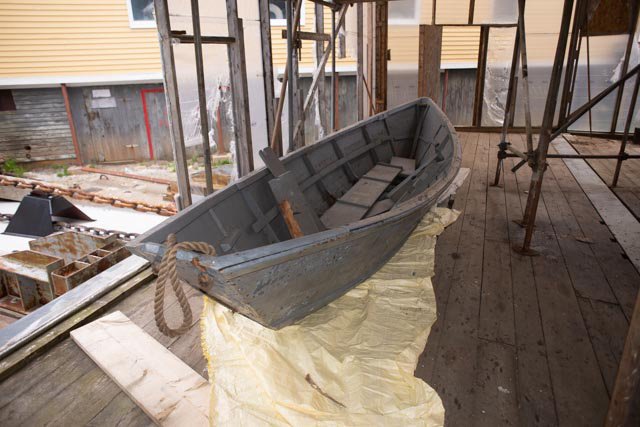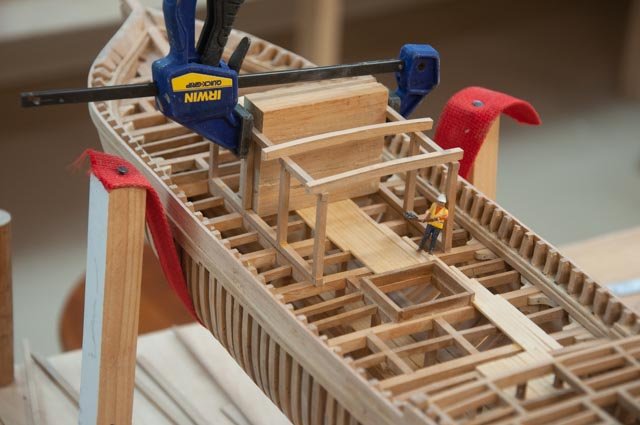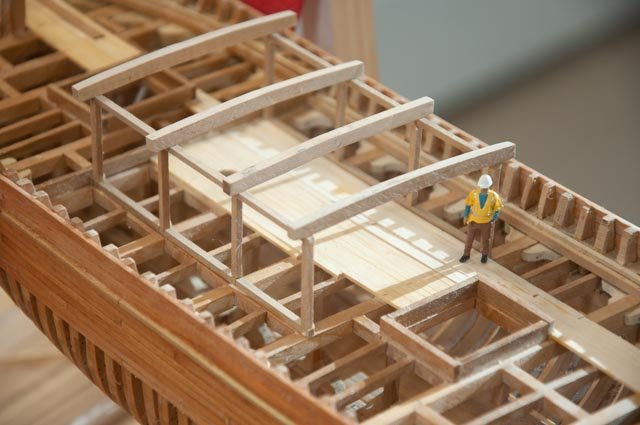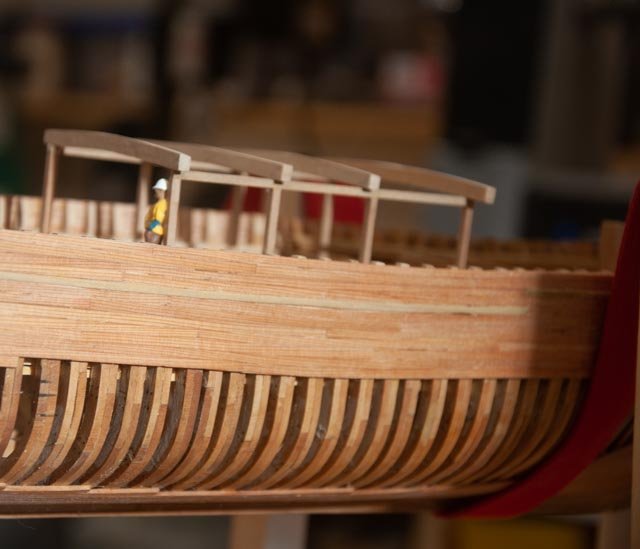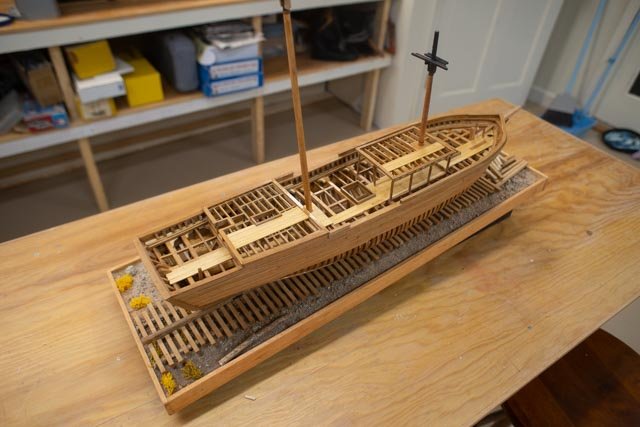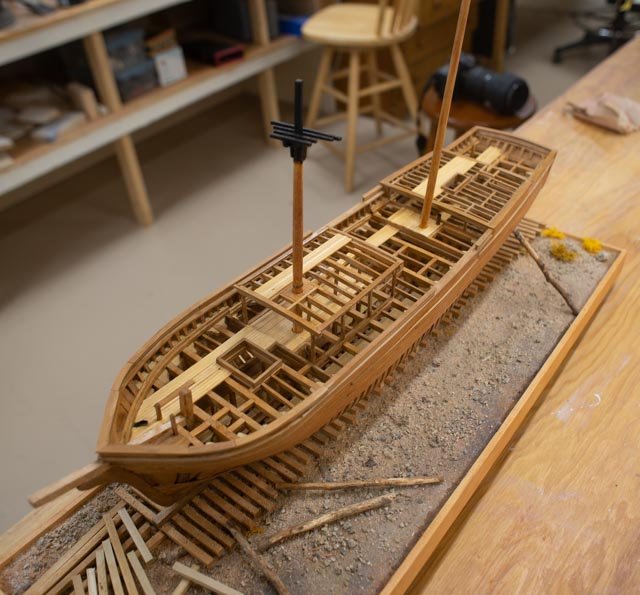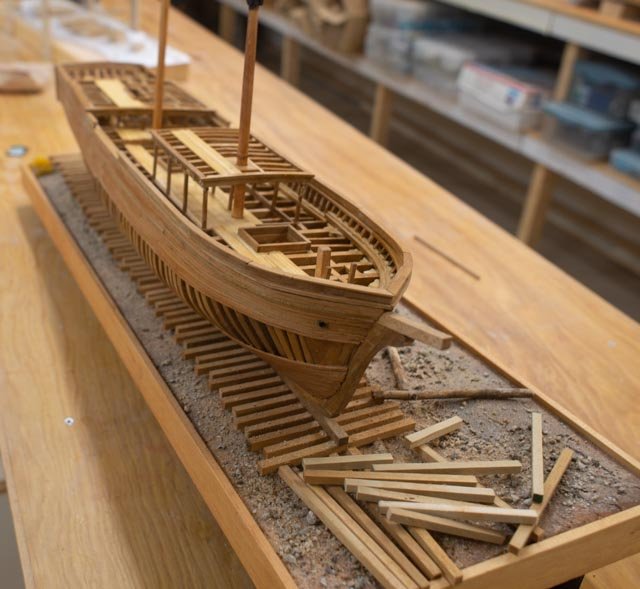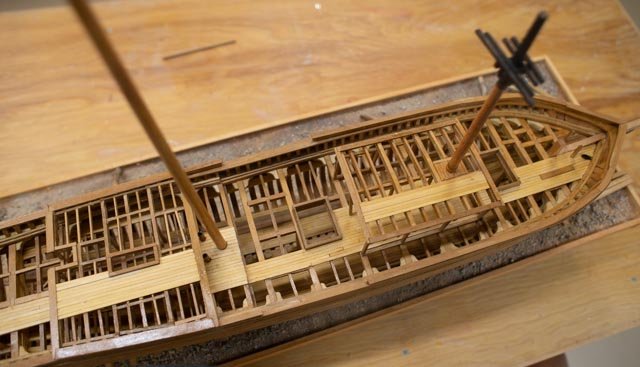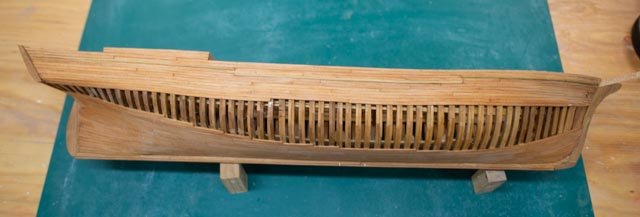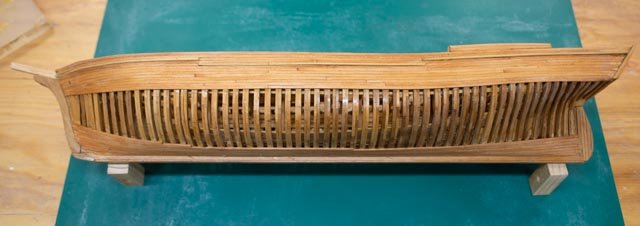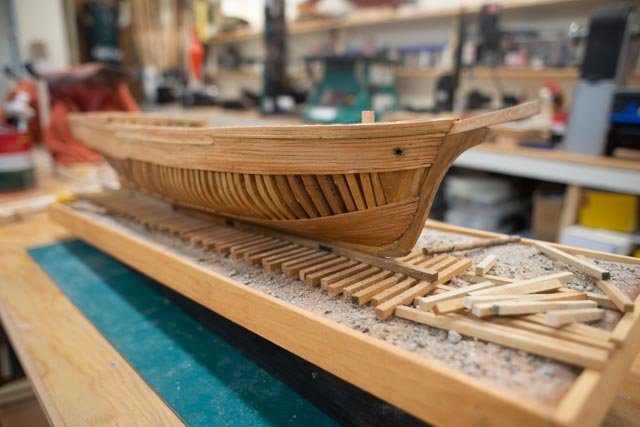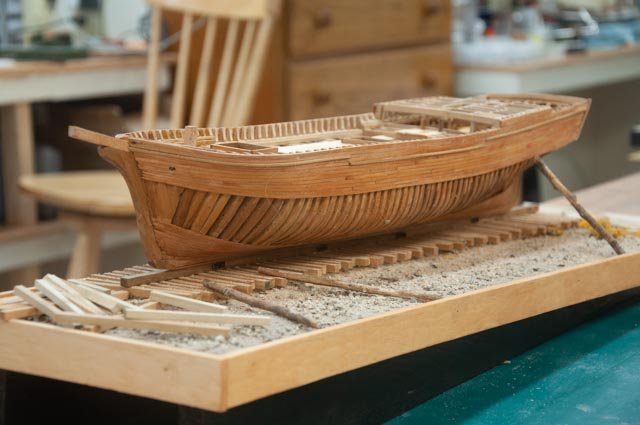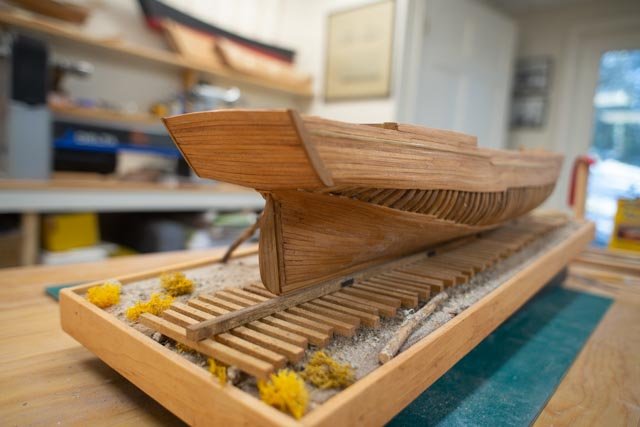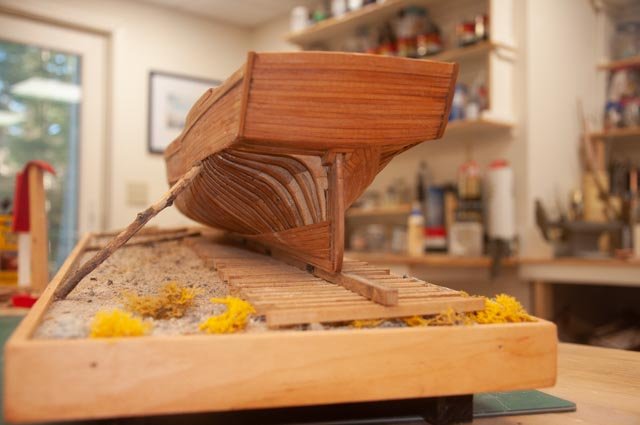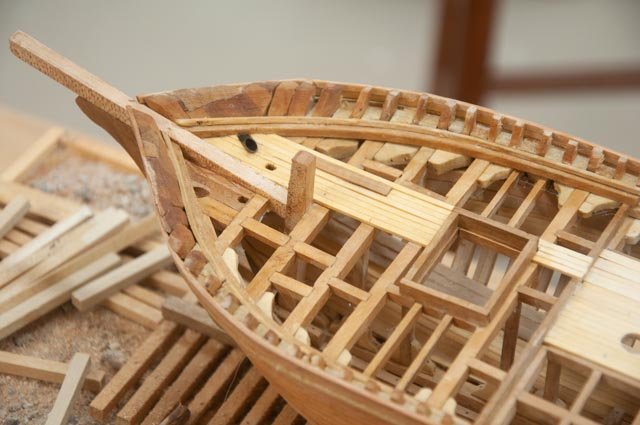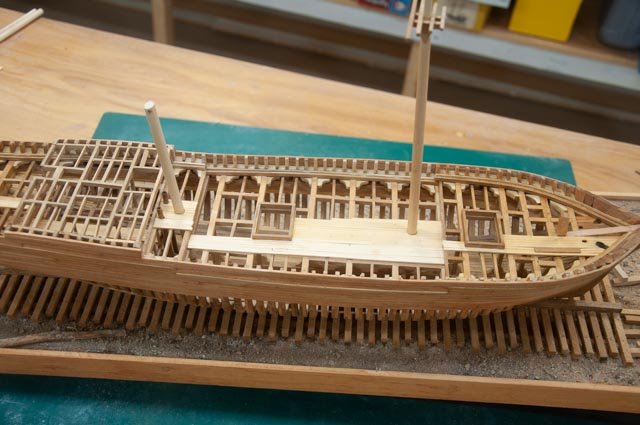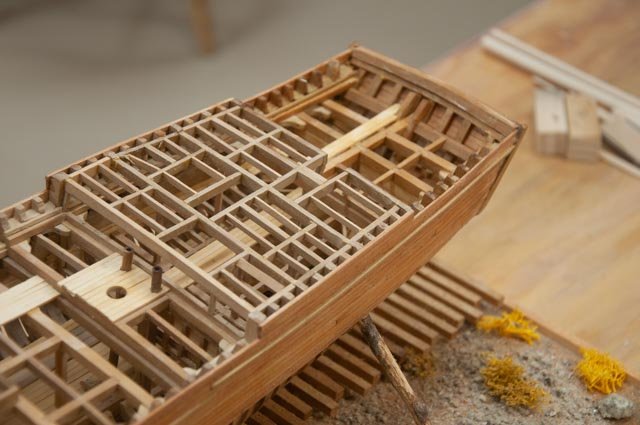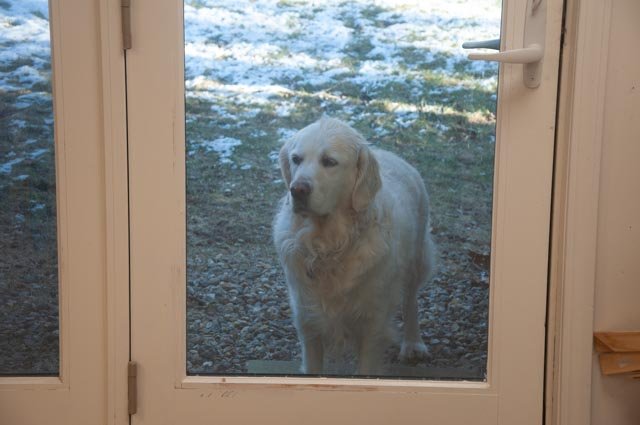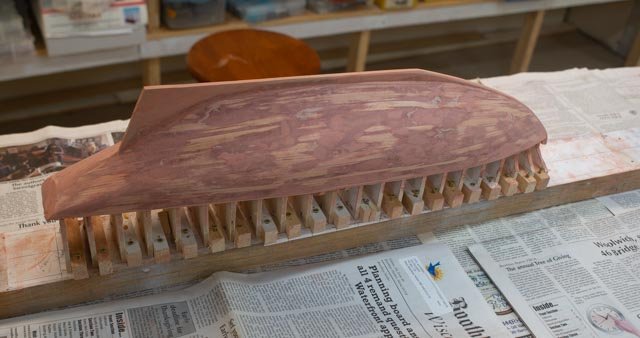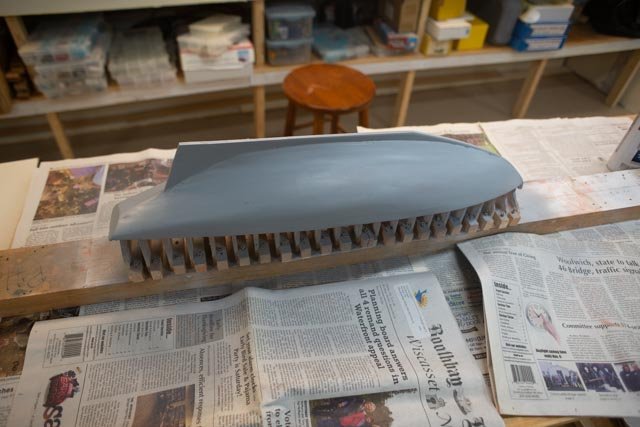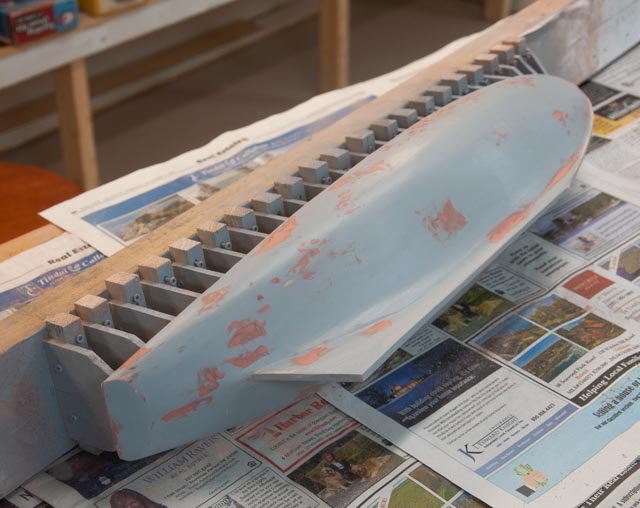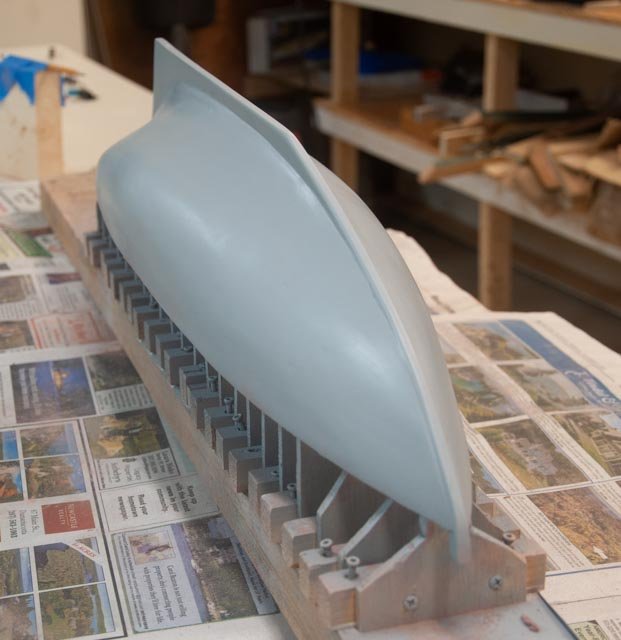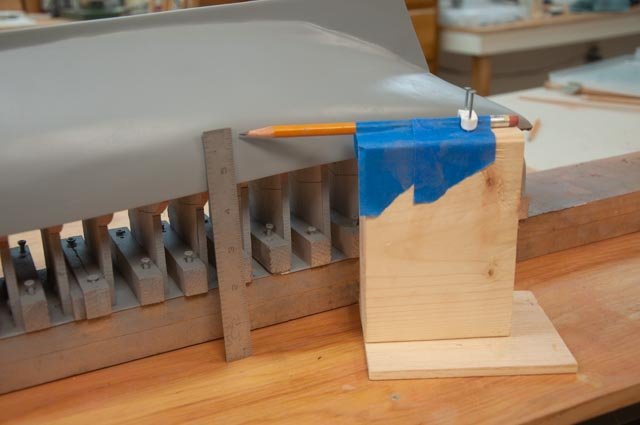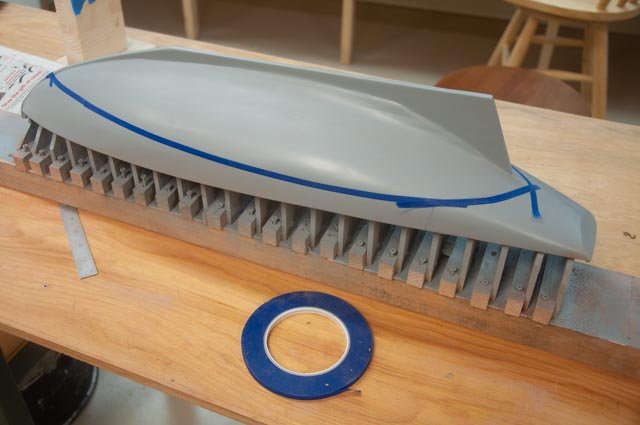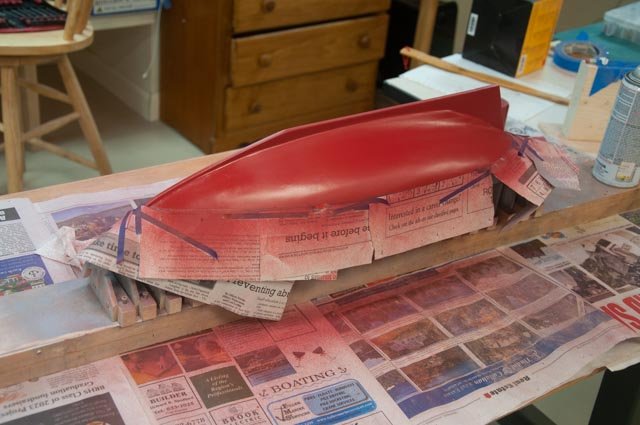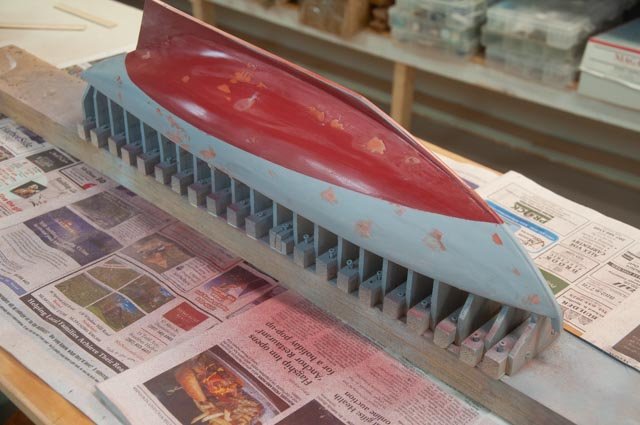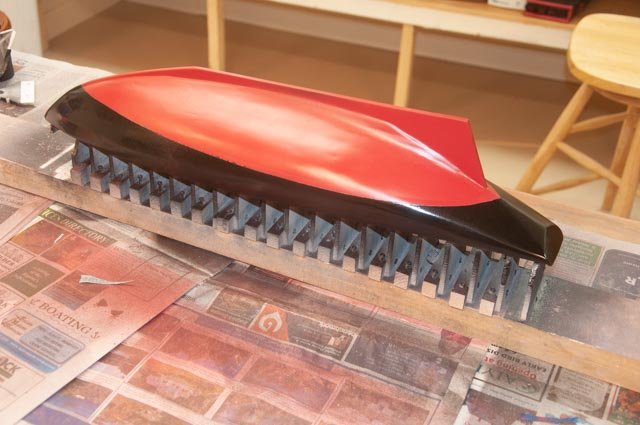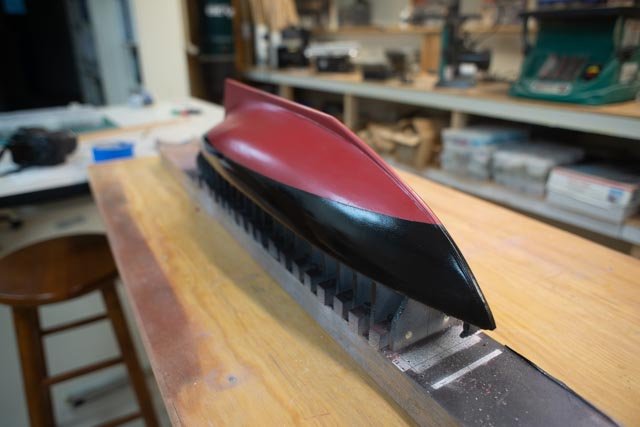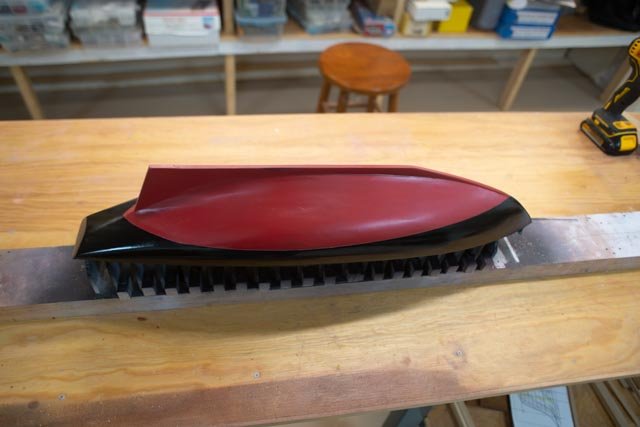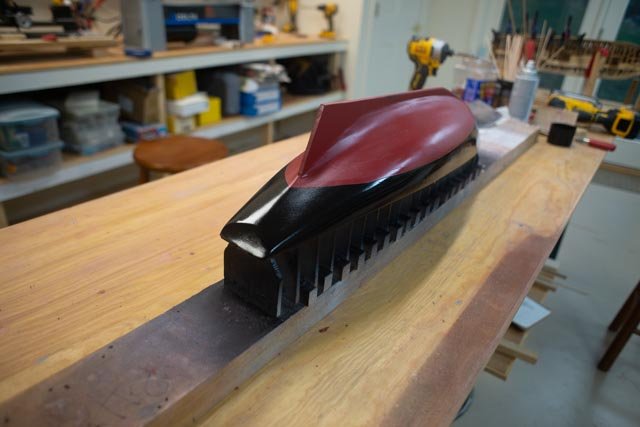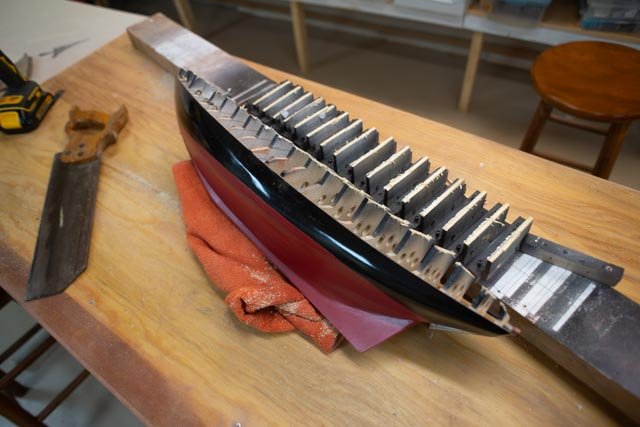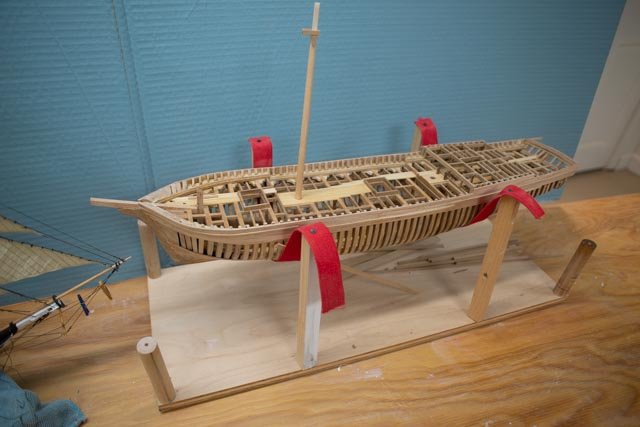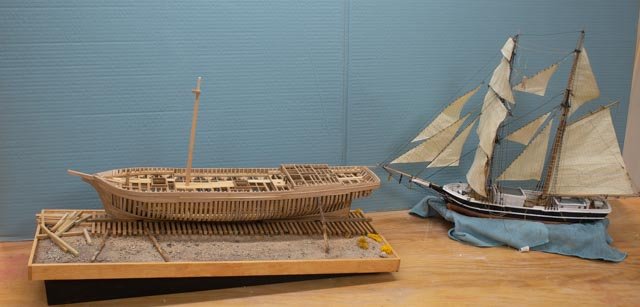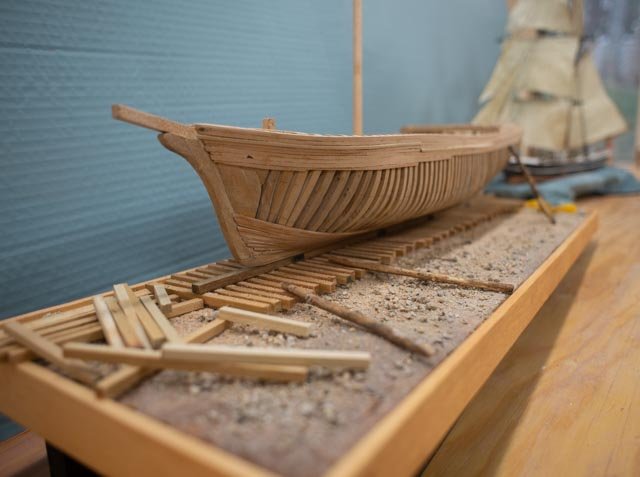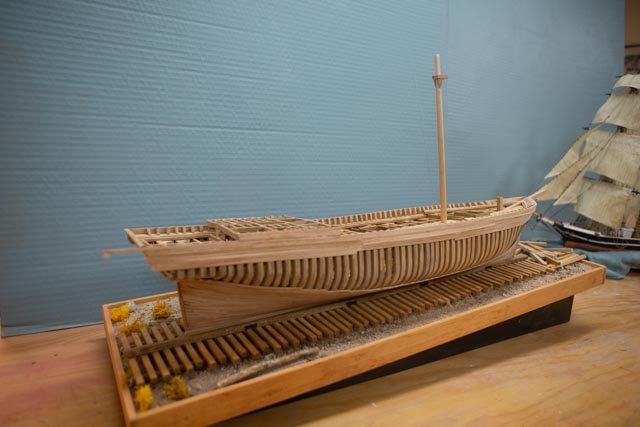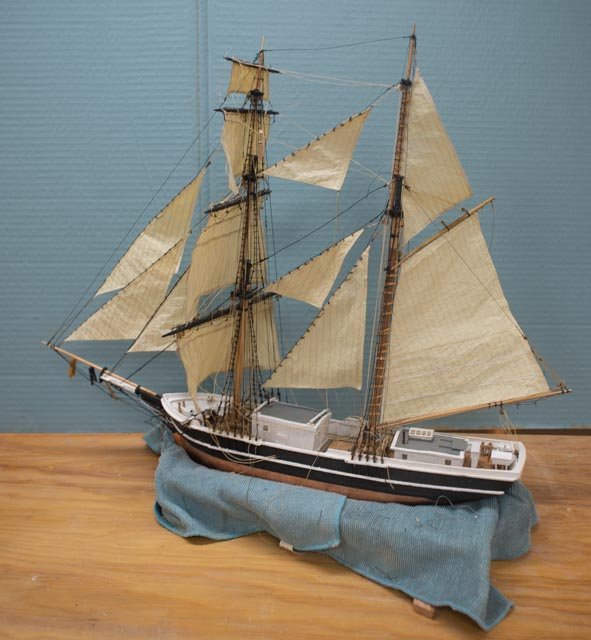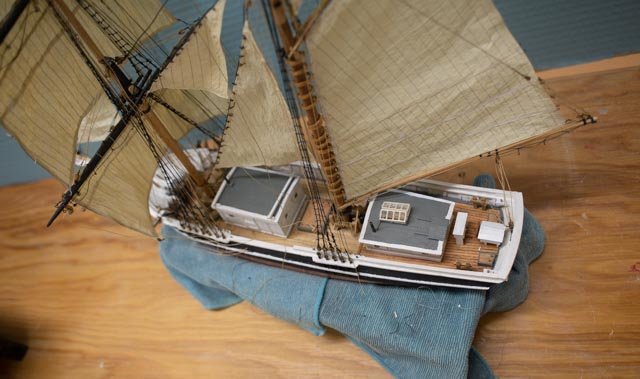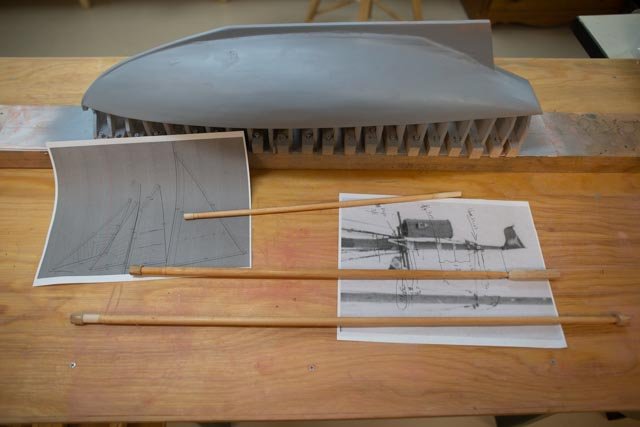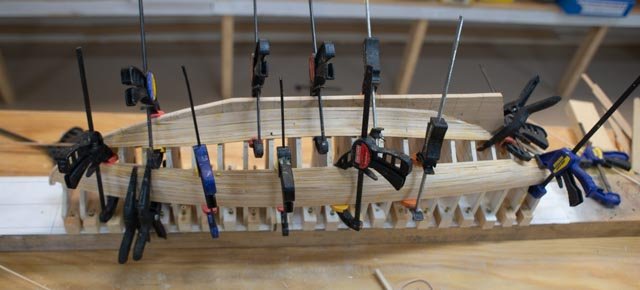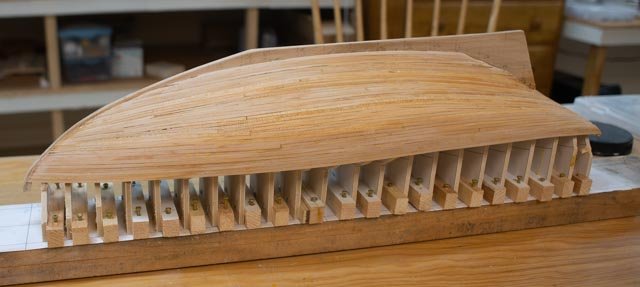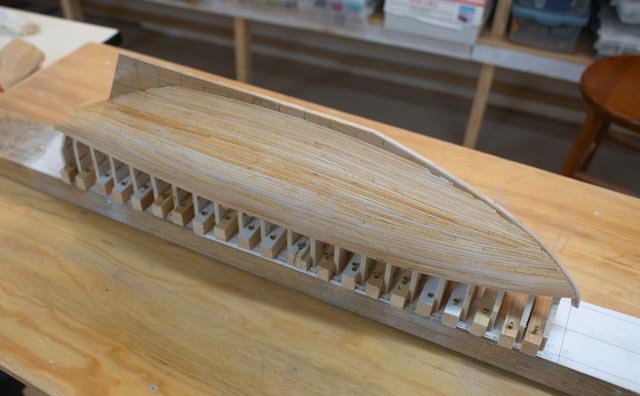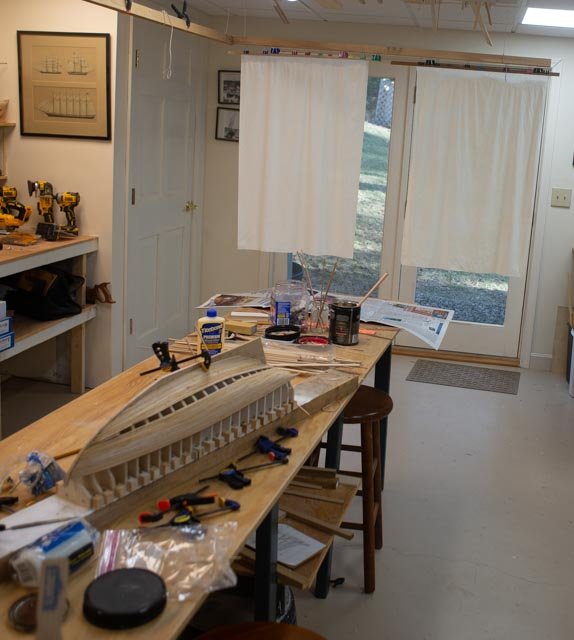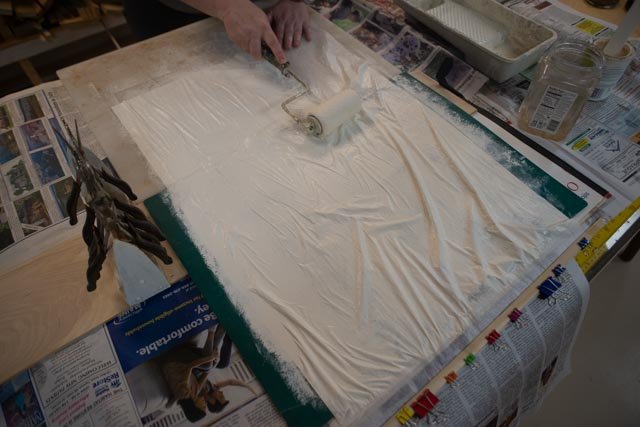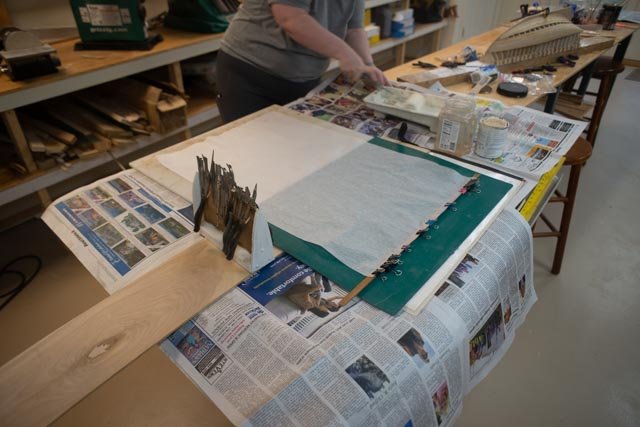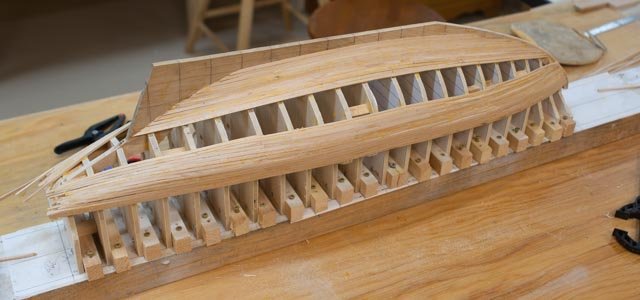-
Posts
862 -
Joined
-
Last visited
Content Type
Profiles
Forums
Gallery
Events
Everything posted by Jond
-
78. the final shots In this final posting we see the H B Berry completed with crew and the the two brigs together at home and downtown at the Boothbay Region Historical Society for the summer season. together
-
77 small sailing half brig is done Now that models are on display, my talk on their history is completed and the shop is cleaned up ready for the next venture, I want to close up this log with two postings. This one is the small sailing half brig. Here are several views of her just before she went downtown
-
for all you schooner Bowdoin lovers out there in 1954 Bowdoin came to boothbay Harbor in June. The undersecretary of the US Navy and other brass came and promoted Donald MacMillan to admiral on the town dock before he left for his last expedition north. This week the schooner Bowdoin was here again and with a dockside dinner and other activities prepared for their first return to Labrador in many years. See below a few shots of her on the town dock and then leaving. Her next port of call is Shelburn, Nova Scotia on her way to Nain, Labrador. on the dock leaving exactly on time 12:30. up with some sails. rain is coming so only two. she was doing 7 knots and away from boothbay.
-
storyboard I just drafted up a storyboard to go with these two models as they are headed to the local Historical society for the summer season. it may be edited a bit before show time. As to the two models, I still need to complete repainting the crew and placing them, set more of the coils and things. set H G Berry on the ways and buy the glass boxes. here is the story that I wanted to include in this file as I keep a work version of these logs for my record. there is a short powerpoint as well as I need to present them at their annual meeting. The Brigs of Boothbay 30 plus Brigs were built between 1823 and 1855. Starting with Caleb Hodgdon in 1823, continuing with William and Andrew Adams in East Boothbay and David and James Adams in North Boothbay, roughly ten smaller 75+/- foot brigs with 120-160 tons displacement were built. Some, like Veto shown here, started out as full brigs with square sails on both masts. They were often converted, as most in the Maine industry found the half brig rig [the aft mast rigged like a schooner] as depicted in the smaller sailing model, to be most efficient. The sailing model represents these smaller brigs. In the middle years the average size of new Boothbay brigs increased to between 180-220 tons. The mid-sized Brig Havana shown here was built on the east side of Boothbay Harbor by Charles Sargent in 1853. His brother Steven and John Weymouth built at least 5 brigs across the harbor in downtown Boothbay Harbor between 1847 and 1855. Also starting in 1849 barks were built starting in North Boothbay and in 1853 ships were built starting in Boothbay Harbor. In the latter years, John McDougall, and the Seavey brothers in Hodgdons Mills, named East Boothbay since 1876, and Steven Sargent and John Weymouth in Boothbay Harbor continued to build larger 100–112-foot half brigs until just before the financial crash of 1857. The model shown under construction represents the H G Berry. She was very similar to the Brig Torrent shown in the picture, and built by Charles Murray and the Seavey brothers in East Boothbay in 1855. She was also the last Boothbay half brig to be launched. Our local builders had moved on to build barks and ships in those final years leading up to the crash of 1857. After the crash amongst sailing vessels, only schooners were built here in the Boothbay Region, before the influx of sailing yachts in the 1890's. During the final boom years of 1853 to 1855, ten brigs, two barks and six ships were launched in either Boothbay Harbor or East Boothbay. When that financial crash came there were two unfinished barks tied up in the financial distress and yard closures. A Bath, Maine owner, the Patten family came and paid John McDougall to complete the bark Ivanhoe in East Boothbay and two local owners paid Charles Murray, our lead builder of the half brig HG Berry, to complete the bark Glen Eden after taking the lumber over to Boothbay Harbor in 1857.
-
Rob I am honored with your visit. I have spent many hours of the past few years running through your incredible builds. I have taking liberty to use several of your techniques...or at least try. Thank you for your kind words. I am all about learning both the history and sharing through talks and exhibits in the local area to celebrate our local maritime heritage. best regards jon
-
Wefalck I welcomed you comments and feel that following them and adding the lower masts was an improvement. My previous build of Ernestina Morrissey, I just put in short dowels where the masts would have gone and was never satisfied with that approach. we learn more every time, so thanks As I. suggested in an earlier post , after analyzing weights and logistics. I believe the lower masts were best installed early. Adding your common sense comment about masts going through cabins, it even makes more sense to set them and then build around them. the weight of the vessel is key. with the 300 plus ton displacement vs the 120 or so of the similar length schooners [ where masts were not installed first], must have been sufficient to take the weight of the mast thanks as always I am wrapping this one up soon and writing the story boards to go with it. thanks to those who joined in
-
14 sort of done To get …sort of done… I needed to get all the sails on, and basic things on deck, tied off, coiled etc. the set the cabin doghouses. A few oops along the way but as I enter April…one month to show time… I think I am OK. After the last posting, I proceeded to get the mainsail ready and set her in place. I was not sure how the attachment to the simulated track would go, so I was anxious to get going. 1 here we see the mainsail in place. I immediately saw what I had not seen before……eeek. The foresail is just wrong. The yoke is too low, and the angle is just too steep. I was aware there was a problem before but had tried to fix it. Somehow my brain did not focus at the right moment, and I completed all connections to what has turned out to be the wrong sail. This episode is an interesting lesson. Back in an early posting I showed the broadside photo of Blue Dolphin sailing, from which I took most of my measurements. The gaff of the fore sail is angled back away from me into the photo. The opposite of foreshortening, [for lengthening I guess] and it baffles many amateur painters. It got me too. As I had family help last Christmas, we made the sails before setting the masts and other spars…….beware of the risk!!!! 2 here we see a new paper pattern behind the errant sail. There is not a lot of room to play with as the blocks for the throat halyard take up some of the available room. 3 here from the back side we see we can just get that flapper up onto the bronze mast sheathing. 4 and here we are today as I celebrate the stage as a new foresail has been bent. 5 here we have another tada view. What remains now is a punch list. Many of those things that we try to get done but seem to take a bit long to do. 6 This overhead shot shows the basic work of the deck is complete. 7 this view show shows a similar stage in the stern. What remains for my final month: • Get the crew selected and placed. • Complete details like binnacle, third small anchor to secure, boom crutches stored on doghouse roofs, water barrels, some odd boxes, more life lines and things as suggested in the photos. • The small boats. This item is big for me, as I struggle as things get smaller. I would more easily build a 40-inch hull than a 4-inch hull. I need three dories and one whale boat. Fortunately photos show they were covered with canvas while under sail……that is an option anyway. • Storyboards to go over the display. • Glass box…. easy…. I only have to buy it. It is the support of the hull to solve. Do I use brass rods into block of wood? Some type of pedestal? That is for next week. All for now
-
13 Getting sails on the foremast and the pulpit built. This stage is always fun. We finally get to see what we are building come to life. 1 Here we see the first sail final on, lines connected, reefing lines done etc. we are almost sailing. 2 In this view we see the smaller dog house/ cabins, reduced in width, now giving room for the boats on deck. They have be reclad and are ready to set. 3. the forward jumbo and Jibs are on and mostly rigged. I see no down hauls in the photos and am hesitating to add them. Maybe later. The pulpit. I believe that is what it is called????. Arg! soldering loose pieces….. 4 here I clamped the top and bottom rings to a sized dowel and then clamped a brass strip on top of them. It sort of worked. 5 here I am fixing a broken joint. 6 finally we are in place. 7 The ice barrel is now more apparent amongst the rigging. 8 in this view we see the limits of view from the sails. I would call it tough duty to be up there. 9 here is a future, when the model is done, money shot. 10 I think it will be fun to display the model with a crew member ridding the pulpit….why not? should I rig a life line? Happy St Patty’s Day
-
12 time to get the deck work done...but A few fixes need to be done first: When David Nutt visited a while ago, he thought I have made the center cabins too wide. He remembered a lot of room on the deck beside the cabins and the ability to walk inside the dory. He also thought the raised impact on the size of the cabin dog houses below was minimal as the whole lower deck was quite deep . and had full dead room everywhere. Now the masts are in and the bow work coming to an end, I need to sort this issue out. 1 here is an overhead shot of what has been done. The mockup dories come from another 10 year ago build. They represent 5.5-foot-wide fishing dories from a sardine schooner of 1903. In the current build with 10 foot wide cabin and 5.5 foot dories there is clearly no passage…..something is wrong 2 In this photo, from David Nutt collection of a 1952 cruise, we can see a few things to help. • Using the people one can tell the dory are clearly closer to 4 feet wide than 5.5. • Using the dory one can tell the edge of the cabin from center is roughly the same width ……ta da….. the cabins [ dog houses] really do need to be cut. • The passageway is less than 2 feet but still enough to get by So off we go and after removing our portlights, and with a little work with some saws we now have 8-foot cabins. 3 here in an overview we can see the better relationship of cabin dory etc. after I cut the blocks down to support 8 foot in scale. 4. in this view better to see the work to get this fix done. • Decking has to be revised and filled in some more…..not too bad • The house cleaned up, roof decks cut back, cladding added, port lights drilled out and set and then trim added. The Second fix is the lettering etc. at the bow area. 5 look more at this phot I knew something was wrong …but what 6 putting this 1952 photo over it I see my goof. The anchor hawse pipe came almost straight out and not down enough. There is no room for the cove line to pass foreword. So, I dowel led up the hole and redrilled very carefully with a slope. Thank goodness the wood is maple so no issues. I did cheat however and only drilled the hole full size. I did not dill it bigger and insert and brass hawse pipe…..sorry 7 here I took some 1/16 tape I had to be sure there was decent clearance. I also confirmed that this size is not good. I need to use smaller tape. It does not come in as many colors. Oh my. 8 the color is not perfect but close. Here we are back together. 9 the other side finally 10 and yes, the stern is all redone too. All for now... I has started the sails and running rigging as I complete the bow deck work
-
76 almost done. My time is stretched between completing this build, which goes on display in mid-May, and the Blue Dolphin Schooner with a similar deadline. The only work I plan to do between now and display I share below. Small Brig. I can no longer refer to this brig….half Brig that is.... as Albert. Doing more research, I find it's clear enough that Albert was built by Hodgdon, but in 1823, two years before they were clearly land owners and building in what was called Hodgdon Mill and now East Boothbay. Our friendly author and expert says it is possible that they came here and built the vessel before buying the land. Regardless as I have moved into writing the story boards and PowerPoint for the display and introduction talk, that the small Brig model will be just …representative of the small size of roughtly10 brigs built here. I will list their names, builders etc. Views 1-4 …Here are views walking around the model. Remaining work includes about half of the little coils and placement of the crew. We have decided that the tight space where the two models will fit this summer there will be no glass box at this stage. She will only be on display until October. Larger brig…yes Half Brig 5. First an oops. I was moving ahead adding the masts and lower shrouds. I found making the little annealed steel loops to tie dead eye to brass chain plates, I broke three dead eyes. Here the good one to the left and the broken one. Then two that I cheated and used black thread. Time is king and with a small supply of dead eyes on hand I went ahead and used the thread…sorry View 6-9. Here is a walk around of the larger Brig. The lower shrouds are on and like other items, the futtocks shrouds, and rattling’s are only done to starboard. I really like the affect and appreciate that Wefalck challenged that Masts ought be on before launch. He enticed me and it was a great suggestion and yes I too believe on these bigger hulls the mast would have been stepped on land. Views 10-13 Here we see the bow, the stern, the length of the deck and down through the structure. I hope it gives a sense of what one of these vessels was like. next up i will share the display and any new oinfo that comes out of the research. I will also have the crews aboard Cheers
-
11 standing rigging is sort of done In this update we see a few normal progressions and a few amusing spirts of trial and error. 1 Here against the snowy window we can see the standing rigging is in place. There are few details to work out and the bowsprit to finish yet. Now a series of spirts...some almost ok and some that need more help. 2 Here we see our unfinished gooseneck. A little aluminum paint and instant galvanized 3. Here when I went to my supply of Bluejacket anchors, I found some missing parts…the stock for the one I plan to use. The copper wire brass washer and glass beads make up my attempt to replace it 4. here a few things. I cut down a Bluejacket winch to almost fit the one on Blue Dolphin. I am no machinist who can make his own. I also fudged the bracket for the jumbo boom and the cat heads. Note the lettering easy to read but a bit big. 5 the letting and scroll would pass if the idea is be sure folks can read it. I have looked, relooked and it is just too big….. 6. this stern lettering again is too big. It is more obvious too, so I have gone ahead and re scaled and reprinted all of it on vinyl sheet and will replace. 7. here the crew has arrived and give us a better look at how things measure up. 8. it was fun that one of the figures is perfect to ride in the crow’s nest…”ice barrel” I need to get the lettering right and continue trimming out the deck ,so I can start the running rigging and sails. More important is the writing and preparations for the talks that start in May and go through June.
-
10 deck done and rigging started. Over the last few weeks, I got the deck on and most of the work on the cabins done. I now have a list of what remains but need to get the main rigging in place, lines tied off etc. before adding too much to the deck. I also want to get more input from David Nutt . 1 here we see the deck planking on, stained and oiled with partially built cabins sitting in place. 2 here from the bow 3 Here an over all view. These views are what I sent to David before his visit. While here he confirmed several things. We confirmed the location of the engine room. Its far forward; about amidship. The color of deck was good because it’s what his father wanted. The pictures from the arctic cruise show it abused and darker. David said he spent a lot of time sanding and refinishing all the bright work, as it was a passion for his dad. We agreed to keep it light. He advised regarding the following: fore and aft portholes for the cabins, type and location of the deck pump, the cutaway needed for the prop, the use of hounds for the shrouds and a few other rigging questions. 4 here I have completed the fore boom and mast and it is resting in place. The gaff is next. 5 here the main mast is mostly complete. The goose neck is underway, and the boom awaits. the top of masts are basically set up. All the fittings are galvanized, and I will paint them out before adding standing rigging. All for now
-
9 starting the deck prework for decking: This stage included getting the mast steps done, blocking between the bulk heads, and laying out the cabins, bitts and raised sections under the buffer aft and the windless up forward. First up is to choose the decking. I loved working with yellow cedar recently, and I have a stock left over. Looking at the photos, and hearing David, the deck was oiled fir. The color slide photos showed a rich dark tone after 25 years of use, so some type of staining will be needed. The planks ran with the sides presumably ending nibbed into a king plank or planks. The first part is clear the second supposed. More than half of the centerline will be hidden by cabins or the raised and painted areas under the winch etc. 1 here is the stock pile of yellow cedar laid out. The photos suggest about 4 inch so what I have will work well. Now for the mast steps. I laid out the rake and position from the embedded photo. After cutting the affected bulkhead and adding side pieces, I set up a plumb bob and yard stick to set the rake. 2 here is the fore mast. The rake 1 inch at 17.5 inches 3 here is the main mast with wedges that I glued in to hold the mast when stepped later. Next, I completed the waterway, stanchions, and rails. I also filled in between the bulkheads using soft Luan plywood scraps. This softish material allows enough umph for cutting out a square as needed to hold bitts and things in place. Also, if I need to attach a block to the deck, there is enough blocking that it should stay. Its ugly but not too hard to sand into shape before gluing down the decking. In earlier builds I laid in a layer of 1/32” birch plywood covered with 1/32 decking. I decided not to use that method this time. I hope I don’t regret it. In those cases, the decking was 1/32” thick bass wood, square amidships so the cabins went is first. Here the cedar is 1/16, full thickness. I prefer this approach as I will have more meat in the decking to all sanding and where needed attachments. I can then set the cladded cabins. I also completed the scuppers, anchor Hawse pipe, bow sprit, rudder fab. And yes I needed the first of several repaintings of the topsides. 4 In more checking with the David Nutt photos, I found a long and large raised section at the bow. This grey section lies under the chains and goes aft, most of the way under the donkey engine. 5 here I combined a dockside photo with a scaled deck plan to lay out the cabins. This screen shot is an image of my first draft. The final draft was adjusted after seeing the added David Nutt photos that gave me better understanding of the distance from the cabin sides to the rail. 6. here I have made up a deck drawing to size and locate cabins by projecting lines from several photos. Now let’s start the decking. 7 here the first few planks were in place. The Luan blocking nicely takes little screw clamps to hold planking in place. The grey raised section forward in under the engine house. The two aft bitts are in. I debated for a while if I would run all the deck and then set cabins above. I have decided to set the house blocks on the bulkheads and blocking and bring the decking to them. 8 here I we are making some progress. Before I can set the cabins, I need to clean up stain and finish the decking. I may also want to add in things like pumps and deck blocks. I also need to g-figure out where all the lines tie off. I have yet to see a belaying pin in any photos….eech. The cabins are rough at this stage, they all need work. All for now.
-
8 Let’s start with roughing out the sails. To make sails in silk span I am using the same method I leaned with my Ada Cliff build last year. My daughter and I experimented with paining and hanging. I later cut out the sails. This year she wanted details, both to prepare, then also to cut out and prep the sails. So, first I went to the drawing board. 1. here is the cad overlay of the sails 2. here is one version of the detail for a sail that she used. I stated before that we have several photos showing us the direction of the seams. 3. Here we have the marked-up template and resultant cut out and edged sail. Two sides, the luff and foot, got string for the interior bolt rope and the leech got fine wire with end loops. The loops are for rigging and the wire shall hopefully hold some shape when rigged 4. In this photo we confirmed the reefing lines. We also see the only image to include a fisherman staysail. I think I will include this image in the story board but not make this extra sail. I would doubt its use in the arctic.
-
7. research and making masts Combining photos that I have been able to collect, I was able to embed a broadside view of Blue Dolphin under sail for scaling, blow ups to get the seams and reefs figured out, and another one to see the mast top connections for standing rigging. I learned from David that the mainsail was on a track. He remembered it was bronze and ‘big’ and the light-colored hoops on the foresail were ash. He had to varnish them he said. Here are three views I used for the review. 1 gave me a good blow up of the mast head details 2 here it is annotated and scaled 3 This image was embedded for scaling then layout of spars and sails To make up the masts I used a familiar process from earlier builds 4 here in a jig with which I cut off the first corner of a Sitka spruce blank 5 Here I keep rotating and cutting the other three corners to end with an octangle. 6 Here we go to the lathe. I have a mini lathe. This feature means I can only make things up to about 15 inches without some effort. Each time I come up with a different solution. For the short foremast we took my favorite anvil and set is across the bed. A single copper pipe made a sleave to house the lower end of the mast that does not get much treatment. 7 to make the taller main mast we added to concrete blocks and shims to extend the bed and asset the anvil and copper pipe 8 my daughter was visiting over the holidays and wanted to try something on the lathe, so why not. She roughed out the masts as well as the sails 9 here we are with two rough masts
-
06. researching deck and small boats On a separate project, a group of us are digitizing the collection at the local historical society. My job is to oversee the photos. Through this effort I was able to gather the Blue Dolphin collection. There are 19 photos in the general group and a separate collection by a local student who traveled on the 1950 cruise to Labrador. That student is still in town. Here are three of the general views courtesy of the Boothbay Region Historical Society. 1 this view is one of the few color images. In noting colors and having spoken with David, when in doubt, his dad varnished everything. The deck was fur and oiled, all the spars were. Douglas fir or spruce. Even the ratline slats were varnished ash. Hoops were ash 2 here is one of many I will use to figure out the deck layout 3. In this close we understand the relationship of the rail, bulwarks, gold leaf cove etc. Here are three views from the 1950 cruise 4. sailing to the dock….in a one-hundred-foot schooner. Not bad 5 leaving town for Labrador 6 back home from Labrador Then, David Nutt Jr has kindly lent me the first batch of photos from his father’s cruises in 1952 and 1954. He says he has so many more, and this prospect is great. These, as asked, where to show things on deck, so I could size things and understand what they looked like in that period. I asked for a focus on the deck. Many of them show activity that will go toward trying to retell a story. For the model they will give me a way to dimension cabins and other deck items to try to replicate that era. 7 here looking aft we can scale the width of the deck at the main cabin, see the water barrels etc. 8 here turned around we not the darkness of the deck when wet. Also, I need help sizing the middle cabins 9 in this view, we see the fore sail gaff, several ventilators and again sizing for the companionway I have been using these photos to draw up a deck plan that will let me get close to the original. A second part of the deck is the search for the two types of small boats. The whale boat, as David Nutt calls it, is sitting in his barn. Wow!!!! I have the first of what will be sufficient pictures. 10 here is the whale boat still in storage. There were 3 Dories on board during these cruises. The story is not yet fully clear. In different photos I see a different dory profiles, and occasionally only 2 on the starboard side of the deck. It is possible that different dories made different cruises. David remembers the dories that were on the schooner for all its final 20 years in Boothbay and that is good enough for me. He believes two of them went off to Detroit apparently with the schooner in 1972. A third remained with David all these years. Last year he donated it to Ernestina Morrissey in honor of his father…….not bad aye! This is a small world. 11 here is the dory at the shipyard before restoration. In the photo she is sitting under the bow of Ernestina Morrissey. So much more to learn.
-
Brigs of Boothbay Punch list This update is just my thinking through priorities for the upcoming season. We are having a special display and talk on the well-known schooner Bowdoin this summer as she is scheduled to pass through Boothbay Harbor again on her way back to the arctic. Therefore, we plan to do the following: move and expand the current Bowdoin display out of the Vessels and Captains of Boothbay display at the Boothbay Region Historical Society. I will be working on the expanded display that will tell the story of the first 60 +/-years of Bowdoin and Boothbay. The Brigs of Boothbay display will then take the place of the Bowdoin. It will need both models and story boards along with a little talk. To see all these moves, happen, I need to focus on this build, the Blue Dolphin build, the three stories of Bowdoin, Brigs of Boothbay and Blue Dolphin. All need to be ready by May…..oh my!! 1) Half brig Albert a) Complete braces and tie off…one to go b) Add 3 pins and tie off main stay sail line c) Complete jib sheets…two to go d) Make coils and set…30 plus to go e) Set cabins f) Paint and install crew…3 g) Drill holes for brass pins. h) Make stand i) Size and order glass box j) Optional small boats. To be added later after small boat effort for several models together. Likely to be next winter 2) Half brig H G Berry a) Complete cabin wall frames b) Complete bitts and things c) Add chain plates d) Set lower shrouds…set two and see. Perhaps set four and set a few ratlines? e) Set lower stays. f) Size and order glass box g) Drill small holes for small pins for keel to sit firmly on the ways center rail h) Set supports posts… decide if milled posts or raw posts i) Paint and set up crew….5 j) Optional hoisting activity. Build a gin pole and rig something being lifted to deck. Then consider having it be rigged to traveler shackle, like whaling tackle to show construction use of masts. Likely to be next winter build 3) Storyboard and powerpoint talk: I have lots of material. I just need to find the time to focus. I will likely only make a few storyboards to post over the models to explain their intent and the brief saga of our 32 Brigs. The power point will be perhaps 8-10 rotating slides to be added to the current slide show of captains and vessels 4) The Bowdoin story boards will focus on the building of Bowdoin here in 1921, being hauled and maintained many times and then replanking in 2021. The slide show will be available for a talk on the history of Macmillan and the Bowdoin before her sale to Maine Maritime Academy. The intent of that talk eventually will combine it with the Blue Dolphin. Blue Dolphin has its own build. There tomorrow.
-
75. H G Berry the rails are on ! An update on the progress of deck work. First up is an oops. I have started a schooner build that I am building at 1:48 scale. This build is at 1:64. I got mixed up and built the rough frame for the deck house way to big.. 1 here we are ..oops a little big 2 and here we are redone at our scale 3 in this view we see the side planking and frame of the fore cabin. The figure seems right compared to the painting so onward we go. Today I am celebrating being sort of done with woodwork. I am now into the punch list phase including perhaps 15 or 20 miscellaneous frame pieces that are missing from the cabin walls. Here are a few views 4 starboard side 5 port side 6 the bow 7 The stern. In this view the masts are most apparent. 8 looking down where we see cabin top, the deck and inside of the hold. This view is to help the viewer to better understand the making of a vessel this size as she'll be sitting next to the smaller version under sail. Looking ahead I will begin some iron work. I will set a few shrouds and stays to support the two masts, tie on the rudder and few more details. I will then figure out what if anything will be added using the figures I have to animate the display. Of course I need to do the same with the other half brig where I am slowly, ever so slowly, completing the rigging. All for now
-
74 completed the hull….sort of This update is to celebrate the end of adding planking to the hull. I have decided to keep the rest open. I cannot call it complete as there are several details to be added and the clean-up [ remove stubborn glue and dust from inside of frames] and oil it all. I use tung oil. 1 here a few days ago I completed the port side. 2 today I completed the starboard side. Too bad this is dry January! 3 here we are sitting on the ways. On this starboard side we have more of the planking completed and we are up against the side. 4 here is the port side with room to show some activity. 5 I had a lot of concern on how the stern would come out. Honestly it is a little bigger than I wanted. To look ok, I needed all the planking so the fashion pieces could go in to make the corners. The soft red cedar is not good for sharp ends. 6. I also added the rudder. I will be adding some iron work later as I trim things out. I also need to figure out how I plan to prop the hull in the display. Let’s look at what remains before we move to punch list and finishing 7 here is the bow section. I have done more on the starboard side. The hawse pipe went in this week. I will add bitts and things after the rails. 8 here in the mid-section we see at the moment the foremast. I am not sure what to do here. I may add the lower main mast but that really opens a rabbit hole. I have the framing for the fore cabin roughed out and want to get it in and then consider if I add any masts. 9 here I have the rough framing almost done for the main cabin. It has more framing as I suspect it had a light roof decking. I will put cabin top decking and then think of if any more like skylight frame. 10 Well my helper keeps me getting up to open or close the door, she only yawned when I explained todays milestone…that is how it goes.
-
05 we are off the building board !! This update is to cover the completion of the exterior of the hull and getting her off the building board. The focus for me in this build is to get a better finish on my hull than previously achieved. I own, but have yet to try, the spray painting set up that so many true modelers use. I will be using "rattle cans" again. I promise to try the spray gun one of these days. The sequence below takes us through about 7 steps , many just repeated efforts to get the preparation better for the final product. Here we go 1. this is using Bondo glazing putty, used normally for auto body work. It is one part in a tube and dries relatively quickly .That is why I really like it. imagine in this photo that eventually it is hard to see defects. 2 I use the filler primer. It helps a lot for us amateurs 3 I expect to have one more sequence but had three times where I use the putty, sand and repeat. 4 this sequence is repeated about three times 5 here is the fool proof low tech water line marker. The pencil lead is 3/16: less than 6 inches off the table, measured from the station patterns. 6 here is ¼ "painter’s tape. It is not perfect but bends 7 I had to spray twice. the first time I used painter normal tape and it pulled off spots of the primer. This time I used newspaper and the light 1/4" tape. Talking with David Nutt jr. this week he remembers as a kid having to paint the bottom with red lead. He told quite a story. I apologized for selecting satin finish "heritage" red at the local hardware store. Note the lack of ugly orange that was in the real stuff from the era. He laughed. 8 Even after the first coat, we find little defects coming through and need to putty sand and paint again. 9 thru 12 Finally we stop and say enough is enough. The finished job ......also the incredible warm weather had let me open the shop door and paint here and not take everything to the garage. And now..... ta da ....off the board 13 end stage 1 All for now
-
73. today I wanted a New Year’s photo shoot to record where we are as 2022 comes to an end. As time is now divided with the new schooner build, things are going slow. That is not a problem I think, as I don't need to have this build done until May. 1 first up.... what is done since last time. The stanchions are almost ready to receive the main rails. The planking is progressing on both sides, but I will be adding more. Lots of smaller frames and the fore cabin frames to add. In this view we see the new sling support to hold things as work progresses. The display. I must figure out the combined plan. The two half brigs are to be displayed together to tell the intended story of 32 brigs built here between 1829 to 1858. 2 In this view we have two vessels going in the same direction. Perhaps they are better headed toward each other. That solution will come together much later after preparing the story boards to be displayed behind the models. The larger half brig H G Berry 3 the larger half brig is shown to be under construction. The port side has the optional space to show some construction activity …. what to do?? 4 The starboard side will have more planking in place. Also note I have stepped a partial foremast. Should I do this step and then partially support it with some shrouds? What do I do about the much taller main mast? One suggestion is to have it on the side ready to be installed. Once the rails are on, and several other missing frame pieces are installed, I need to clean it all up and get some oil on. The small half brig Albert 5 not much has changed in the last few weeks. I peck away at the rigging 6 here we see a mess of loose lines as I am slowly getting them tied off, and I have started putting on the coils. The cabins are sitting loose for the photo. I cannot install them until all the lines are tied off. 7. here I have started the braces. They are the last running rigging to go in. everything is loose currently. all done for this year.....Happy 2023
-
New Year’s Eve photos added to recent post Today I wanted to record what is done as we close the year. I will do an update of the process to get here next week some time. 1 Hull….here is the second prime coat over glazing putty. The blemishes are reduced, so about two more sequences of sand putty sand and prime to get ready to paint. In front we have three photos that I used to design the masts and sails 2 Masts….here we see the other side of the hull and the cad rendition of sail and spar design taken from the embedded and scaled photo. Also, there is a blow up that shows the detail of the mast tops. The two masts are Sitka spruce. 2 Sails. Here the patterns were made using photos for seem direction. More on sails later as all the finish work needs to be done next. Happy New year
-
O3 BD 2022 year end update. The hull is planked! My goal was to get the hull roughed out in this first month of the build. I also enjoyed the experiment to try to use maple for planking. I learned how hard it is to work with and perhaps why it does not show up as a choice of materials that I have seen before. Fortunately, this to be Bondo, then putty, then a painted hull. 2 As I began the middle band, I was able to use simple clamps until the last few planks. I then used wedges. It has been great that my daughter visited us again this year for Christmas. Last year she helped me with the first time learning and production of preparing silk span material ready for the sails on the schooner Ida Cliff. This year she again helped. To do big sheets it really is better to have two people. 3. Here is the set up. A lesson learned was to take a thin strip of wood at the top end of the sheet before painting and place at least 6 small clips. This approach would mean that when picking up the wet silk span there are many points of tension, not just two hands. One then adds just two bigger clips to hang the wet sheet to dry. As we found last year latex paint works fine. We used up the can. 4 while rolling on the paint, I continuously sprinkled more water into the paint and roller at the roller pan. I also lifted the wood strip to drag forward the sheet, so the line between the green cutting pad and cement board would not become a defect in the paint. Thank goodness for those strips of wood. 5 here we have hanged the completed sheets at the end of the work bench. These sheets are the full size as they come from Blue Jacket. The hull is a day from completion underneath as the paint dries. And just a day later we celebrated. I have set all the planks and done some rough sanding. 6,8 Here are two views of the hull. Planks are on, and the first rough sanding is done. I need another session of sanding then will fill and make smooth for painting. The maple was too hard for me to twist in all areas, and I have about ten little holes at the transition to the keel. I am not into steaming to make things more pliable. I made all the planks 1/8” wide with a few of the finals a bit less. My spiling was simple sanding since this hull is painted. Happy new year
-
just a quick update as the we head into the holidays. I am experimenting using maple as the planking material. It is definitely hard. It doesn't soak up water and twist . There will be a lot of mending to do. The first two bands are done, now the fun one in the center.
-
Ron Thank you for dropping in. It was good to catch up the other day too. I have enjoyed some of your other anecdotes regarding your personal history with this wonderful schooner. I hope as we get through this build and the fun next summer you think more about building one.....maybe and RC version. cheers jon
About us
Modelshipworld - Advancing Ship Modeling through Research
SSL Secured
Your security is important for us so this Website is SSL-Secured
NRG Mailing Address
Nautical Research Guild
237 South Lincoln Street
Westmont IL, 60559-1917
Model Ship World ® and the MSW logo are Registered Trademarks, and belong to the Nautical Research Guild (United States Patent and Trademark Office: No. 6,929,264 & No. 6,929,274, registered Dec. 20, 2022)
Helpful Links
About the NRG
If you enjoy building ship models that are historically accurate as well as beautiful, then The Nautical Research Guild (NRG) is just right for you.
The Guild is a non-profit educational organization whose mission is to “Advance Ship Modeling Through Research”. We provide support to our members in their efforts to raise the quality of their model ships.
The Nautical Research Guild has published our world-renowned quarterly magazine, The Nautical Research Journal, since 1955. The pages of the Journal are full of articles by accomplished ship modelers who show you how they create those exquisite details on their models, and by maritime historians who show you the correct details to build. The Journal is available in both print and digital editions. Go to the NRG web site (www.thenrg.org) to download a complimentary digital copy of the Journal. The NRG also publishes plan sets, books and compilations of back issues of the Journal and the former Ships in Scale and Model Ship Builder magazines.


